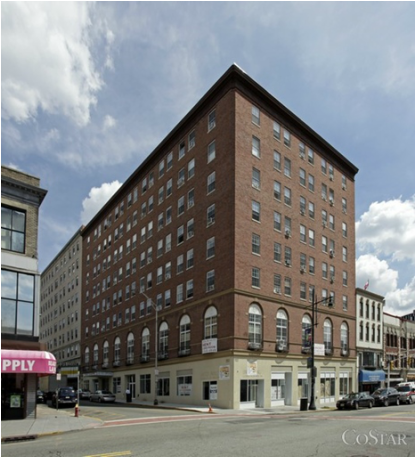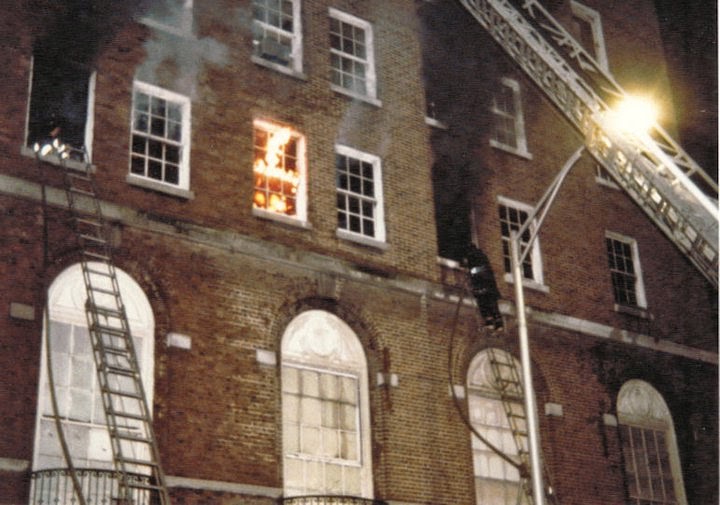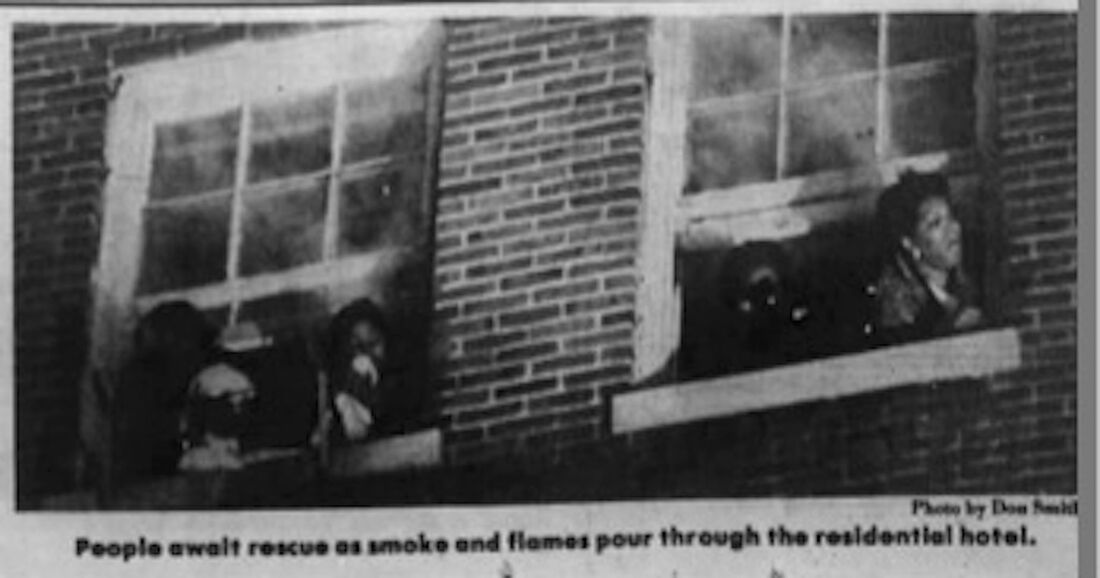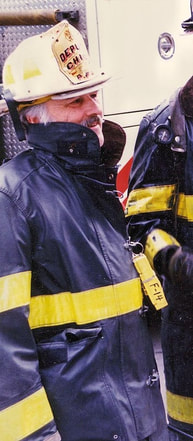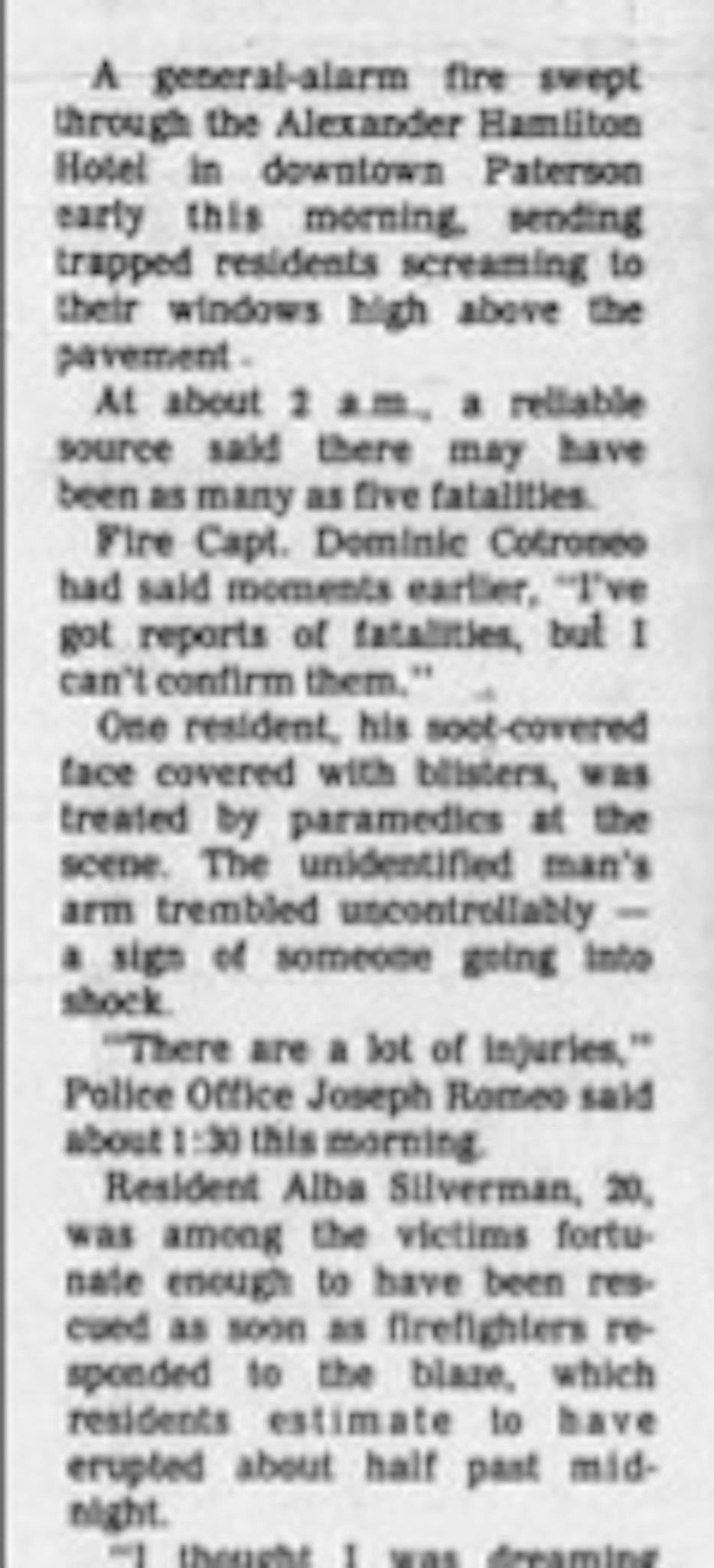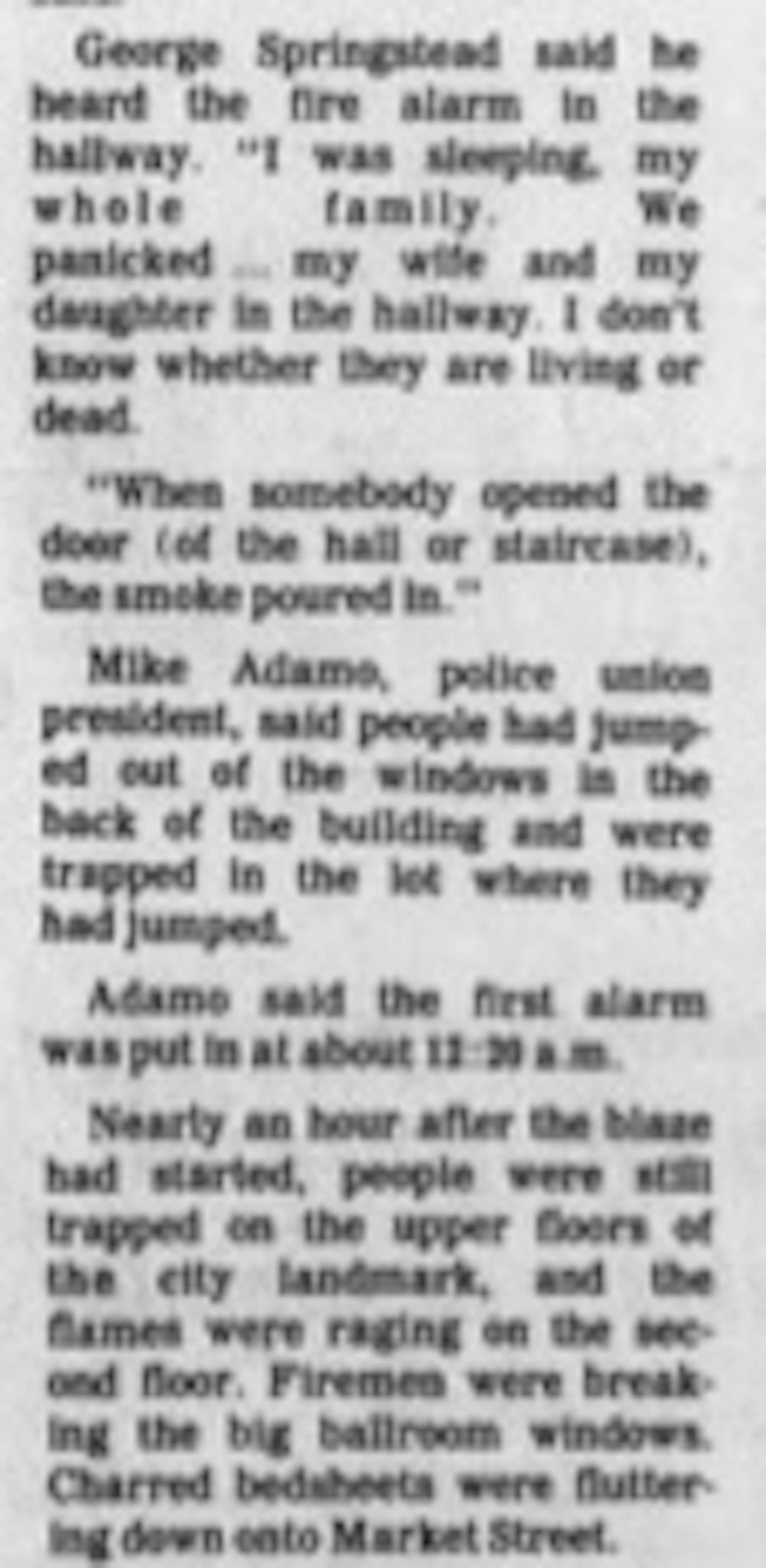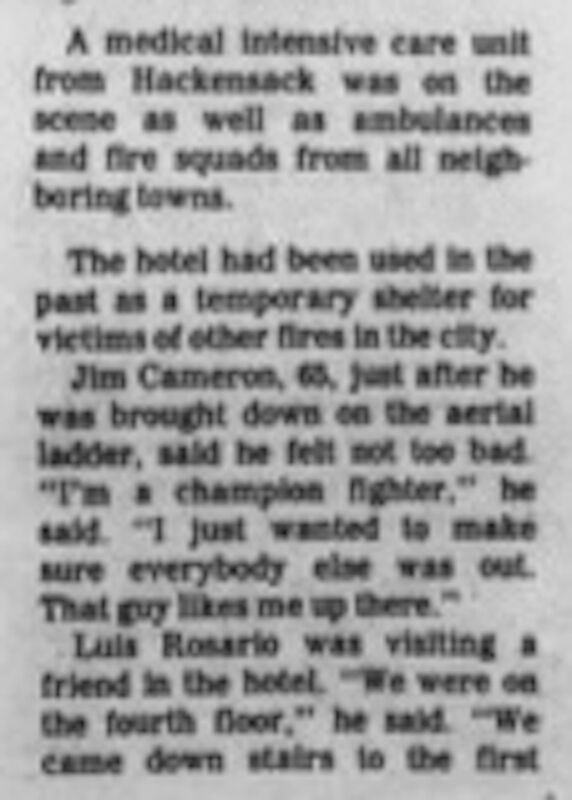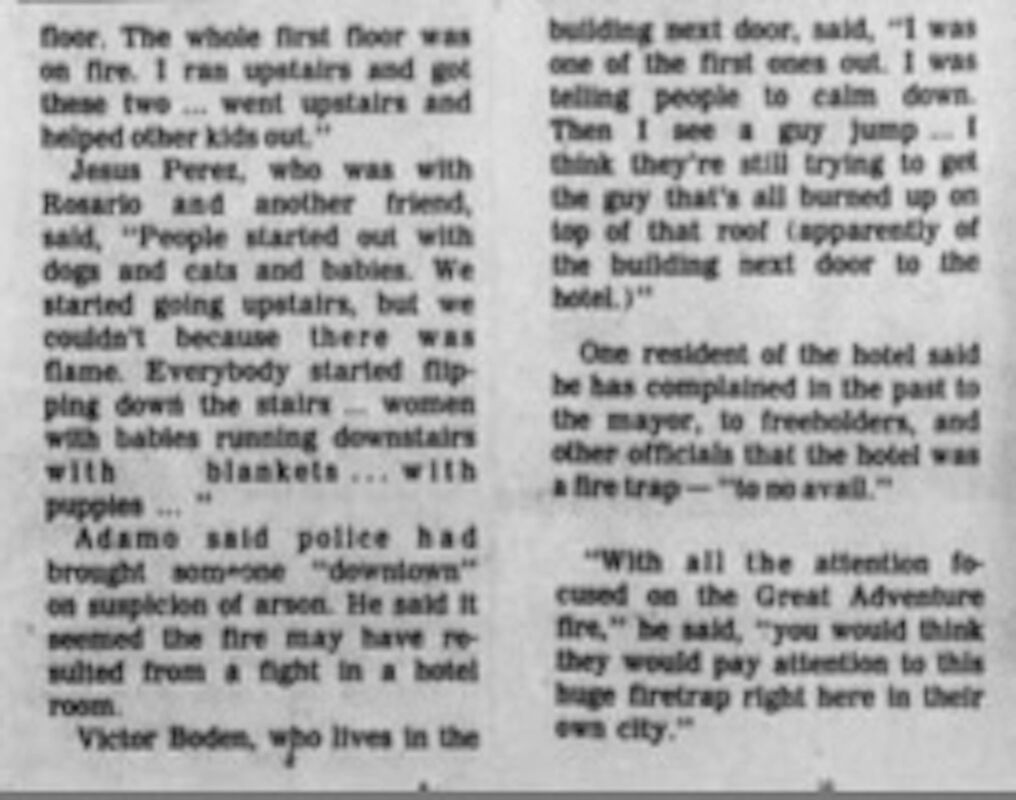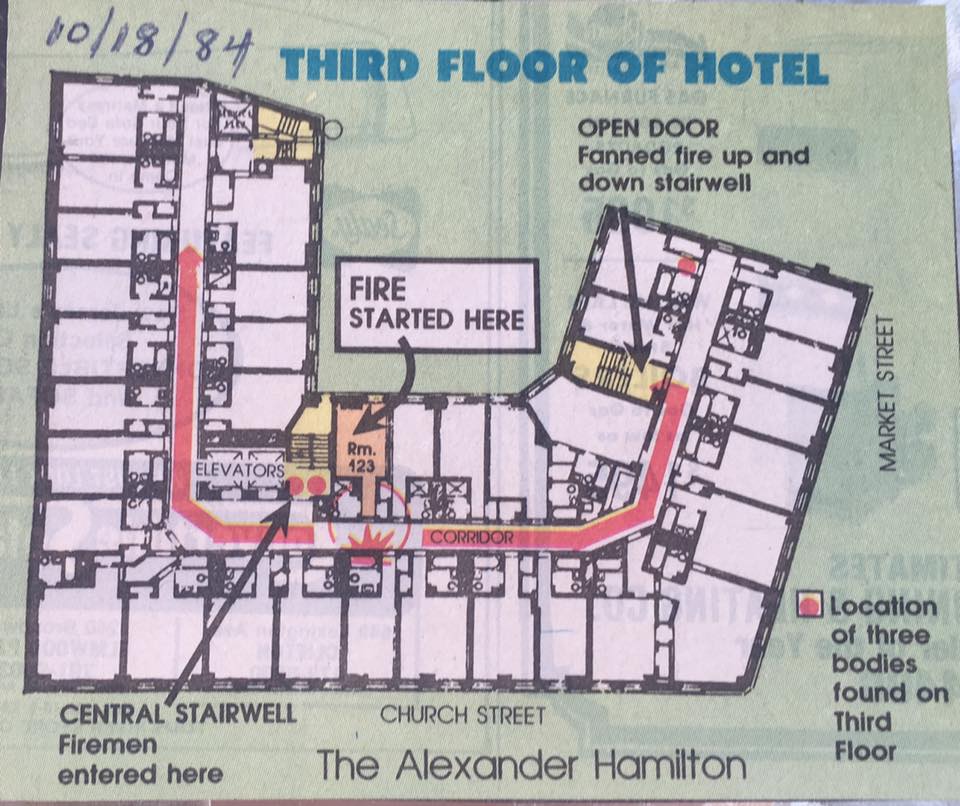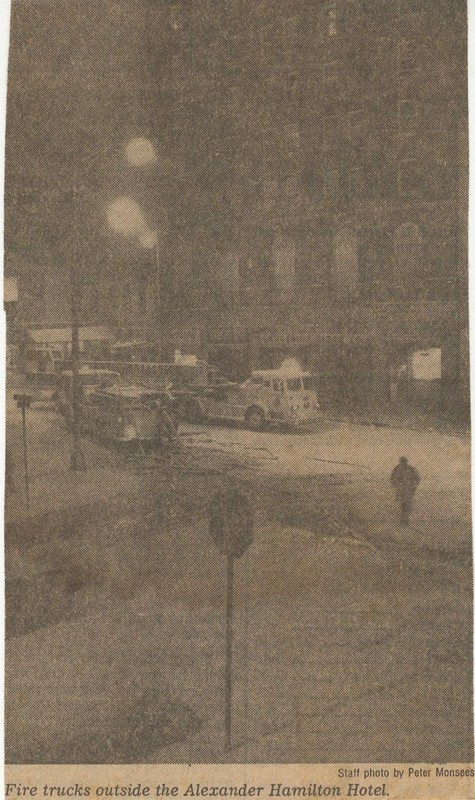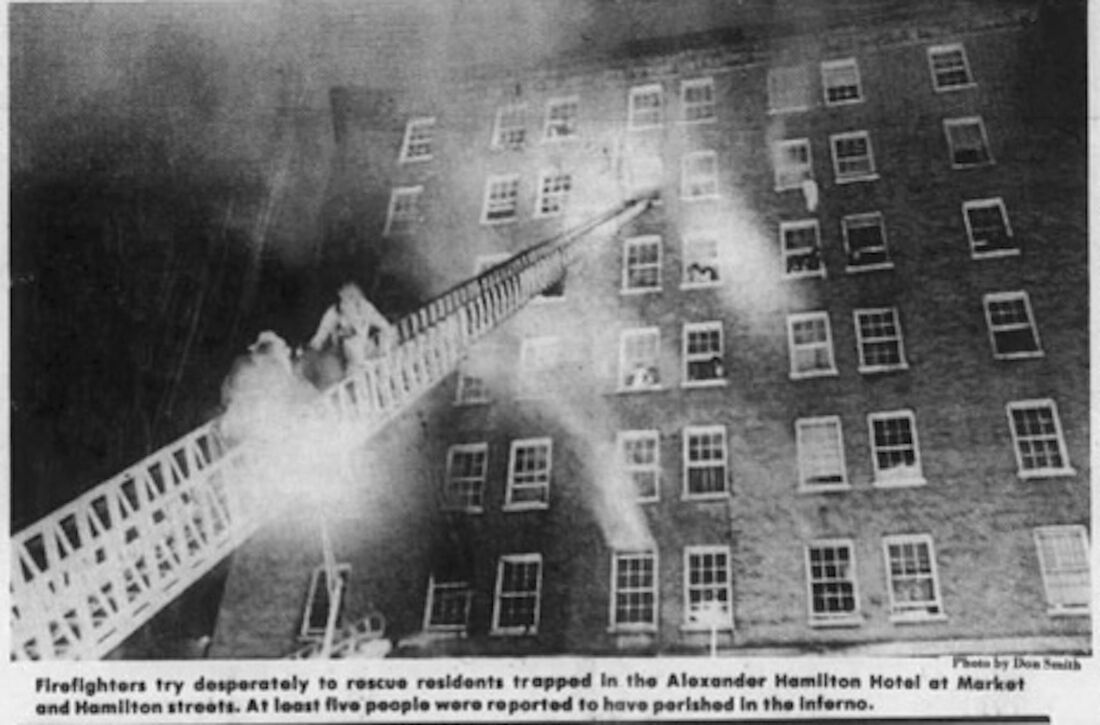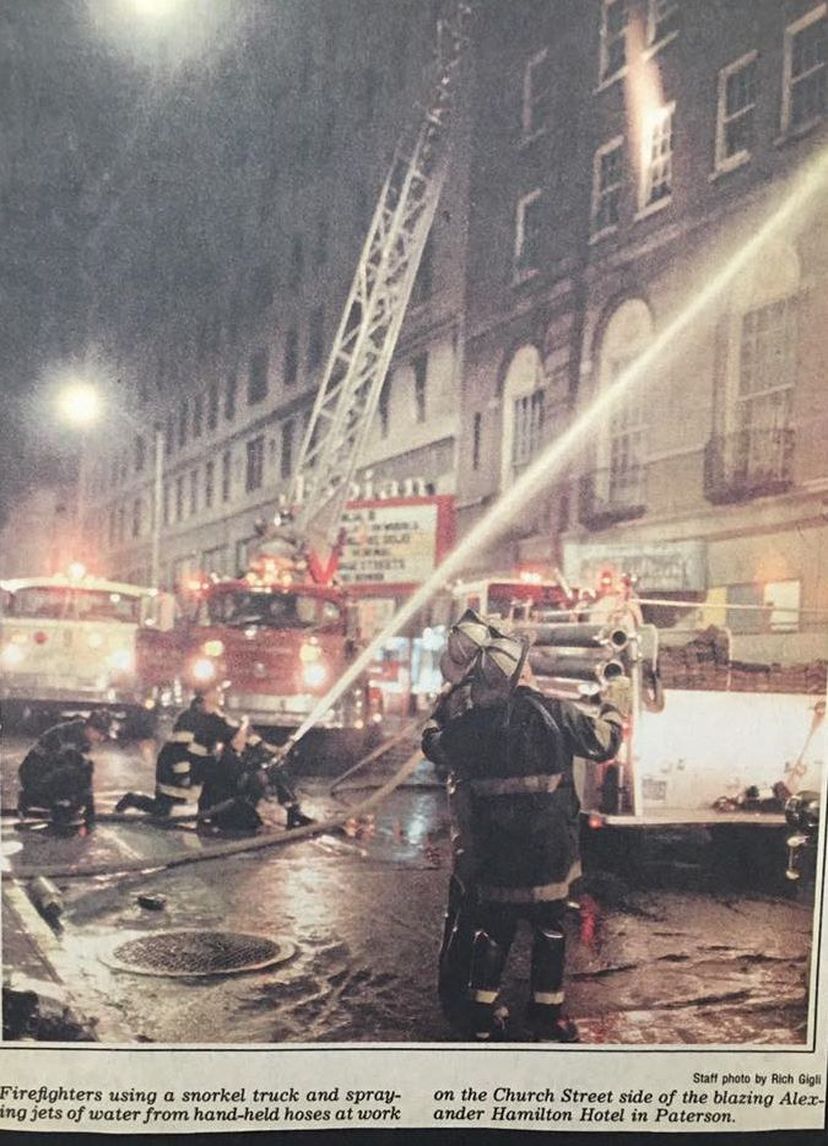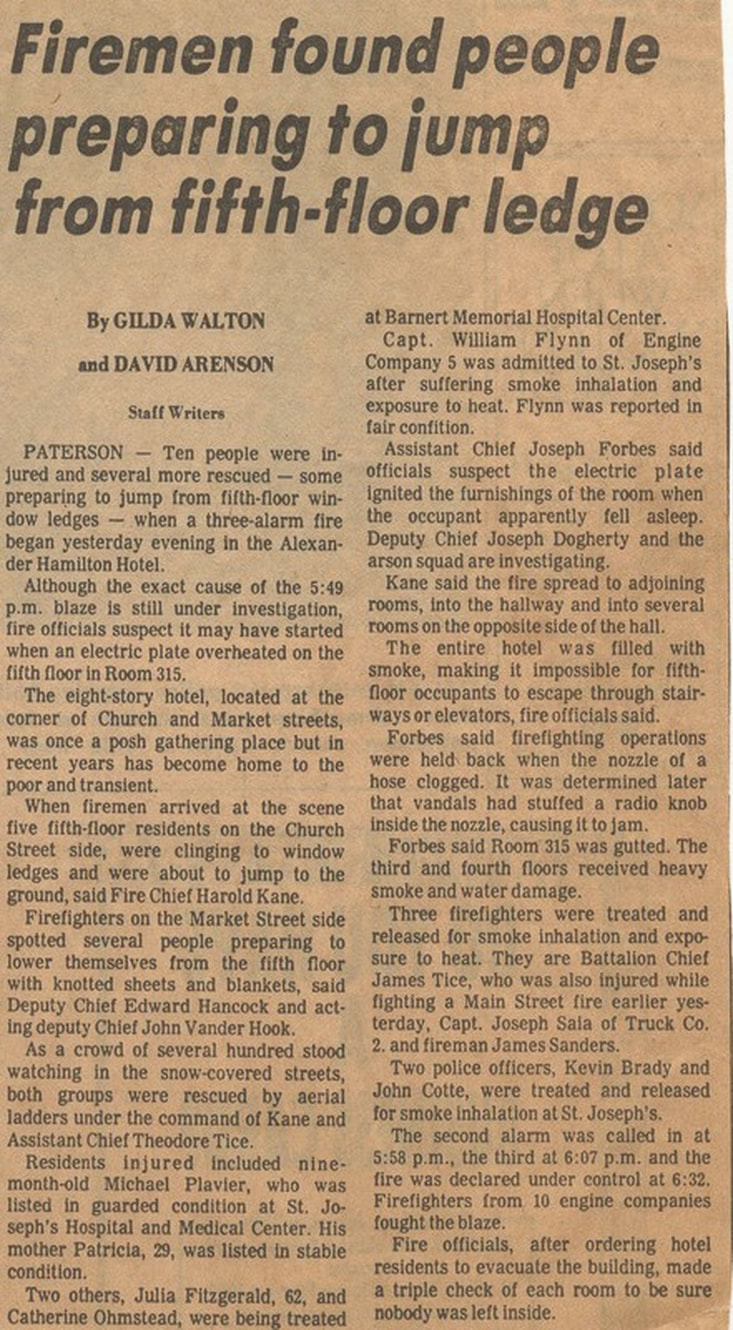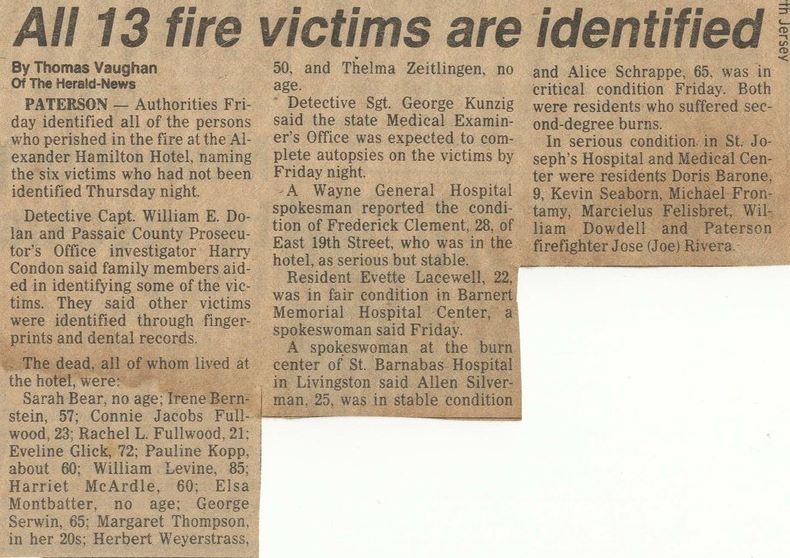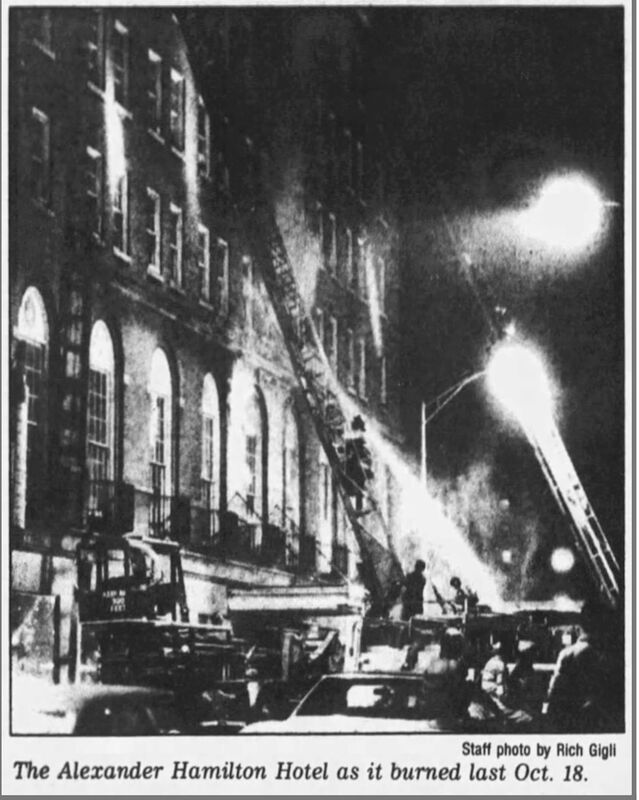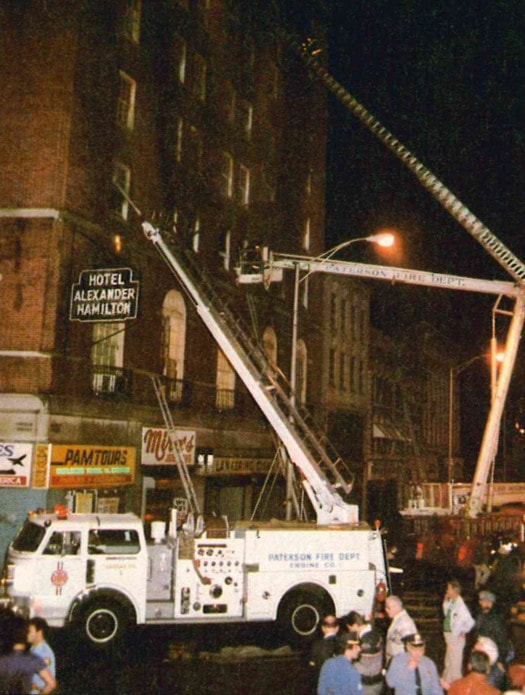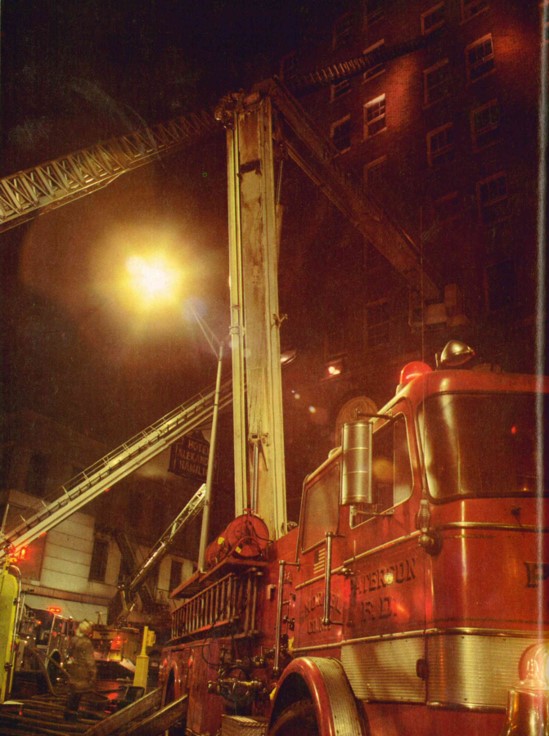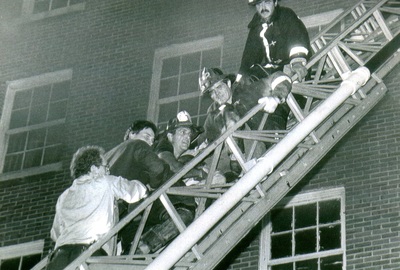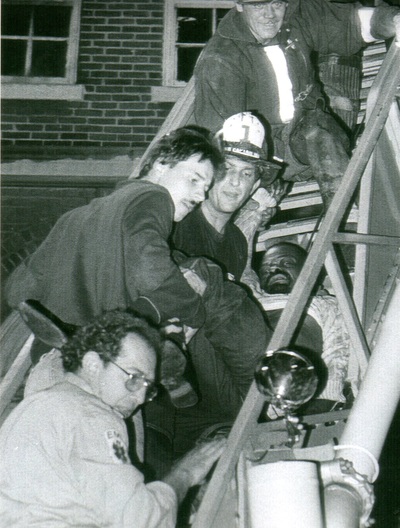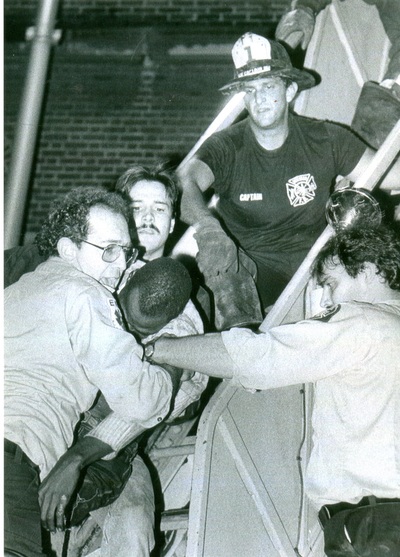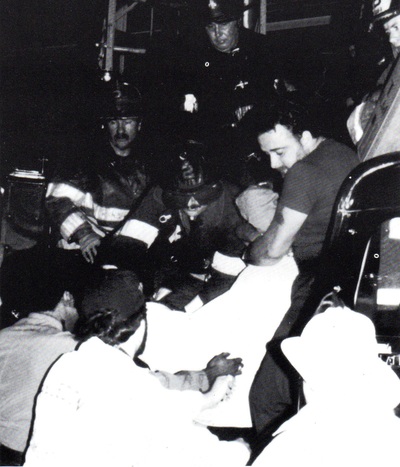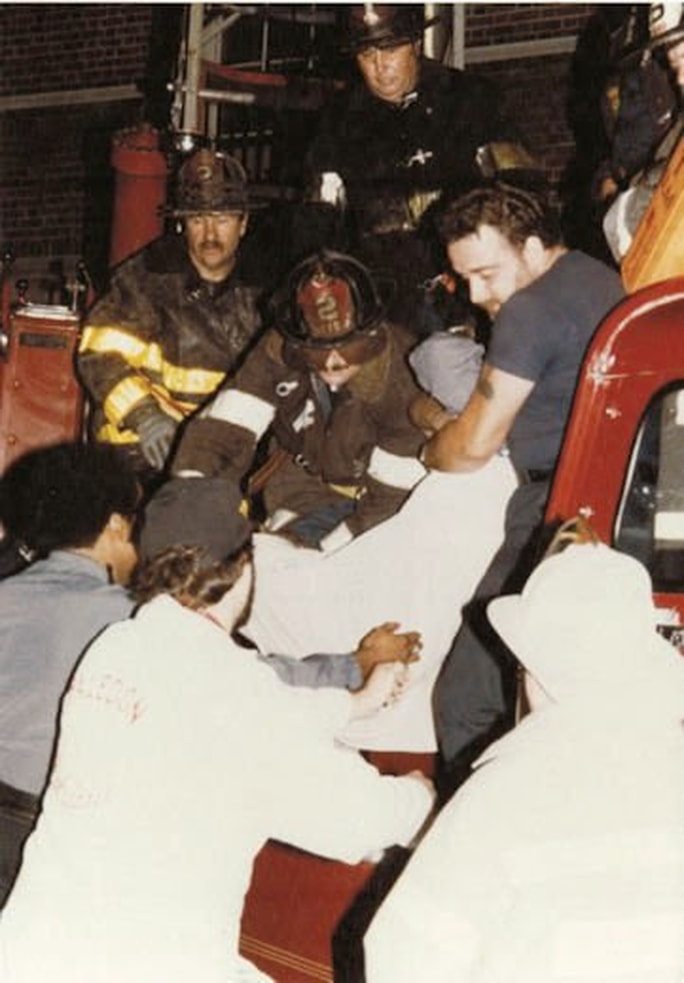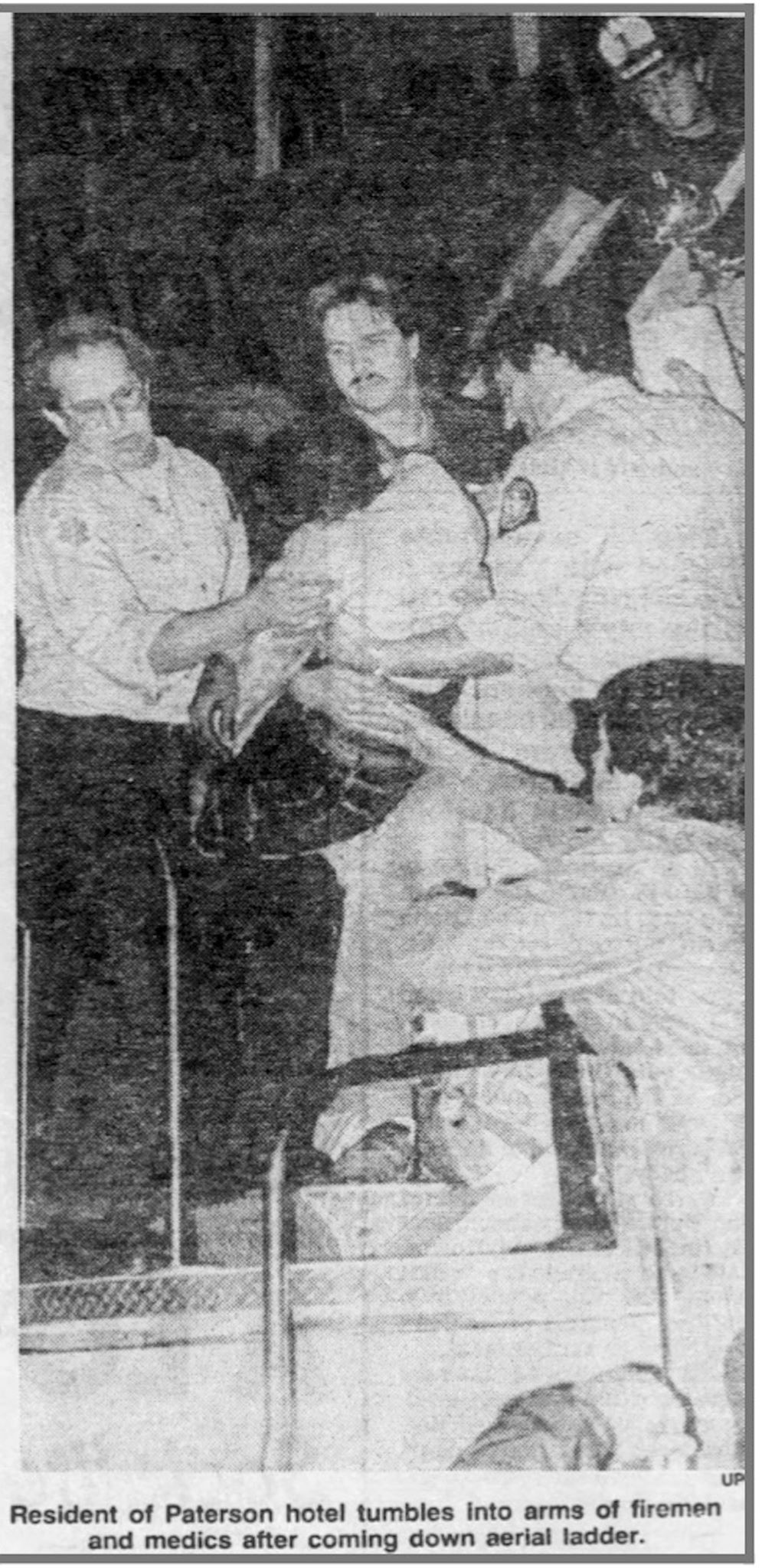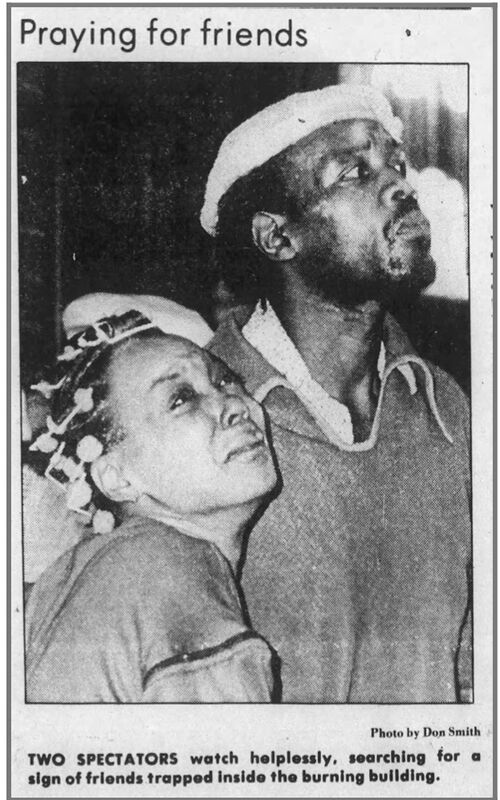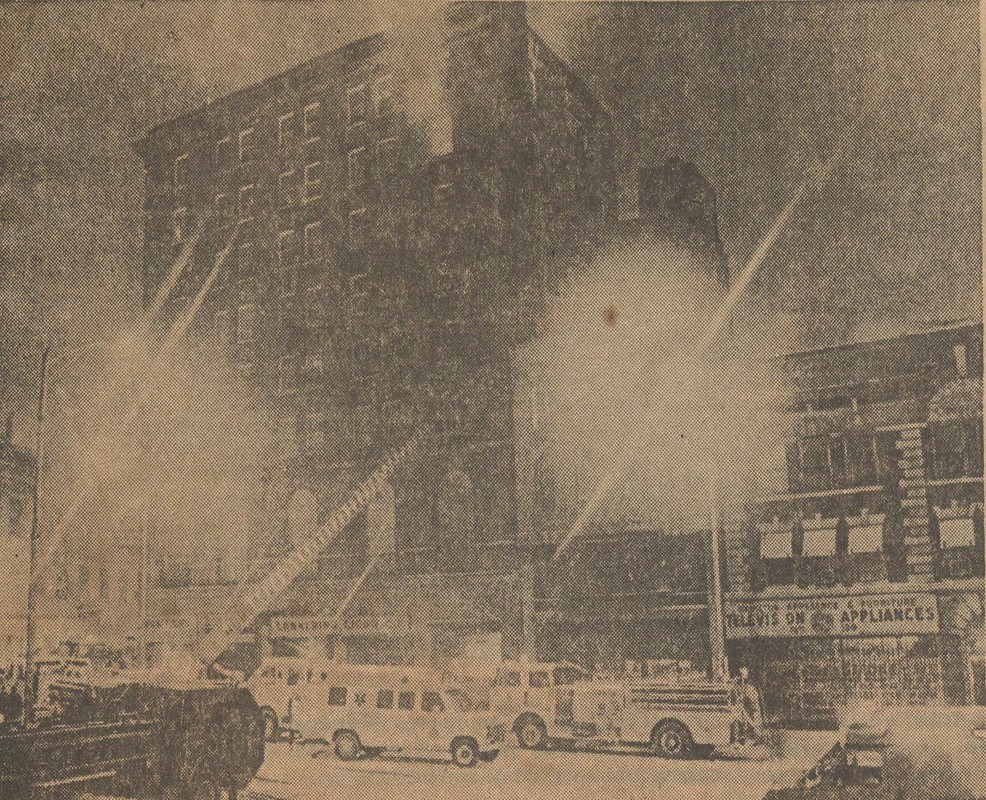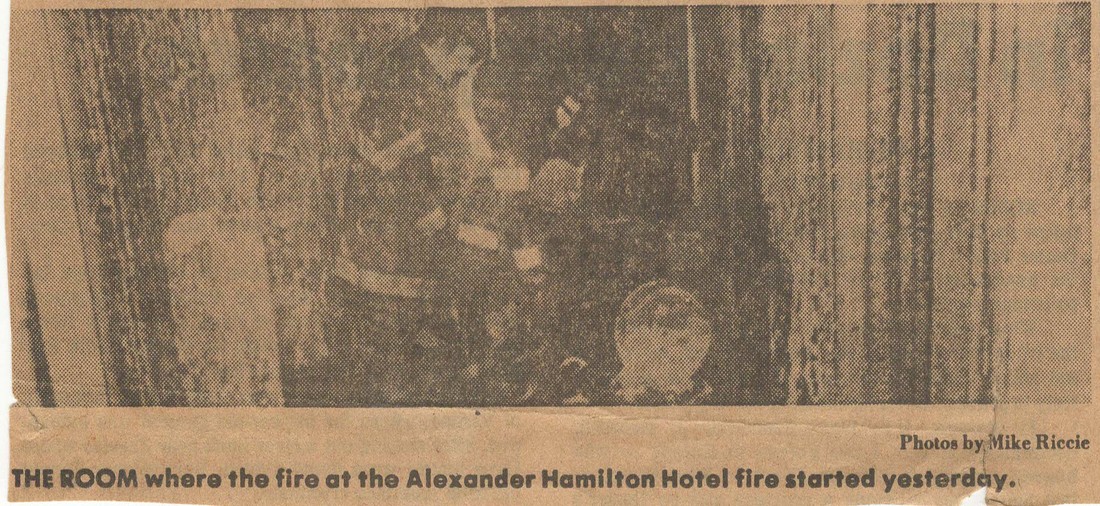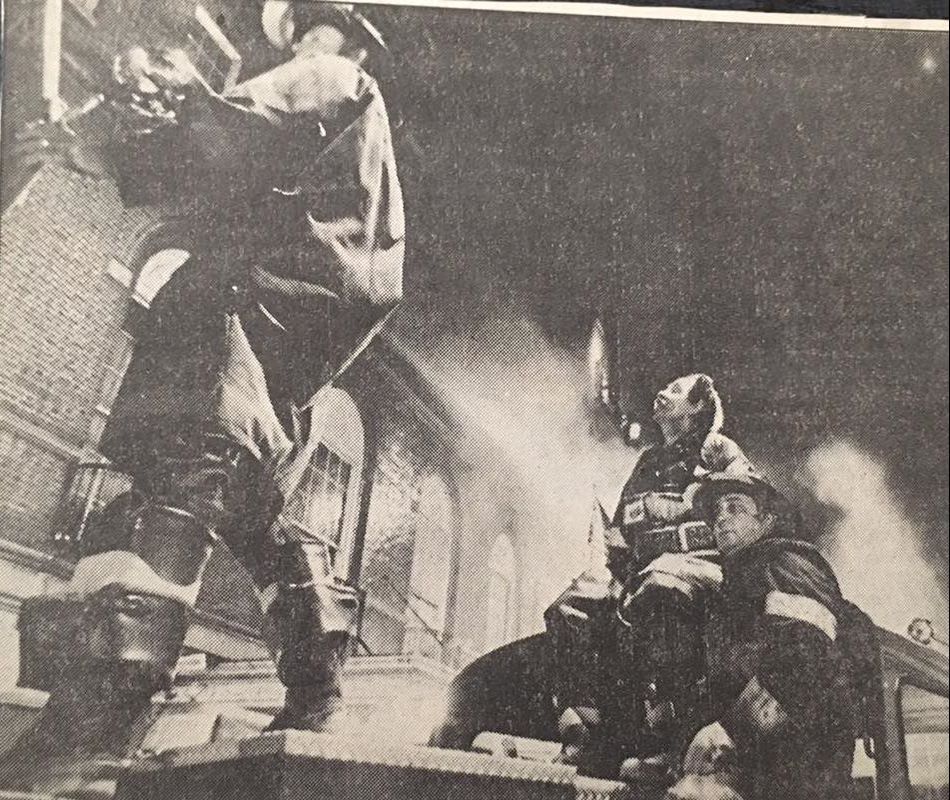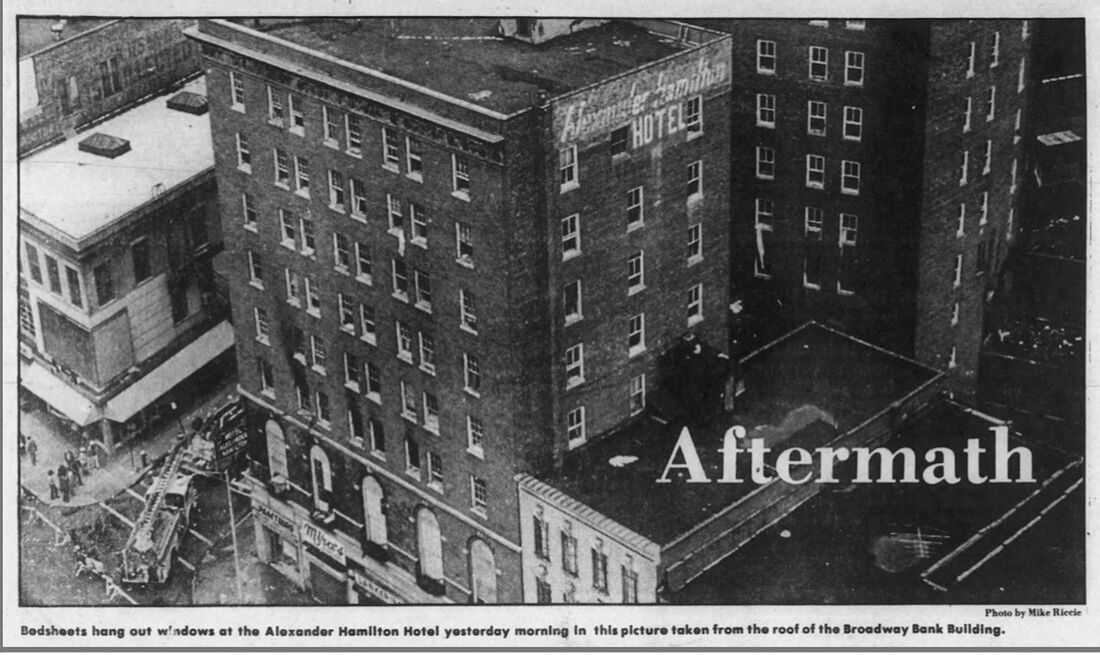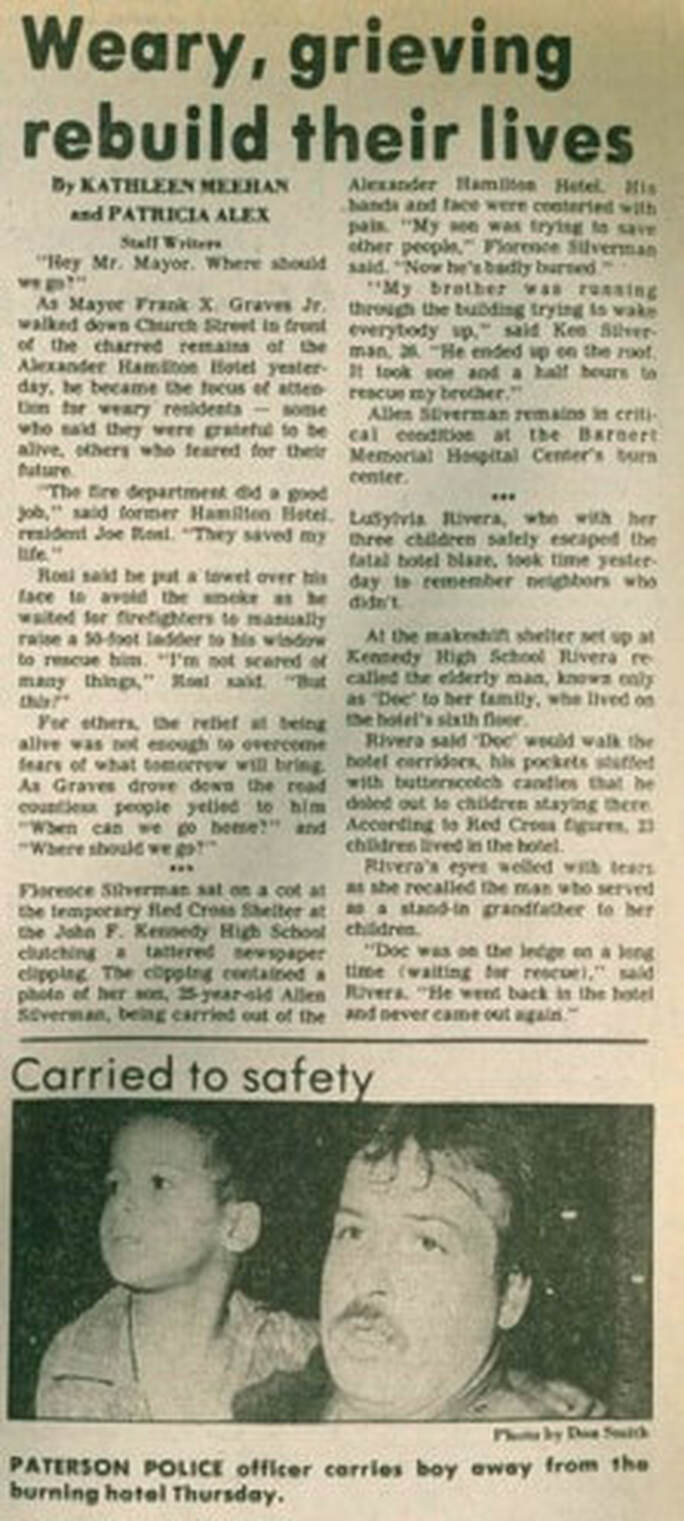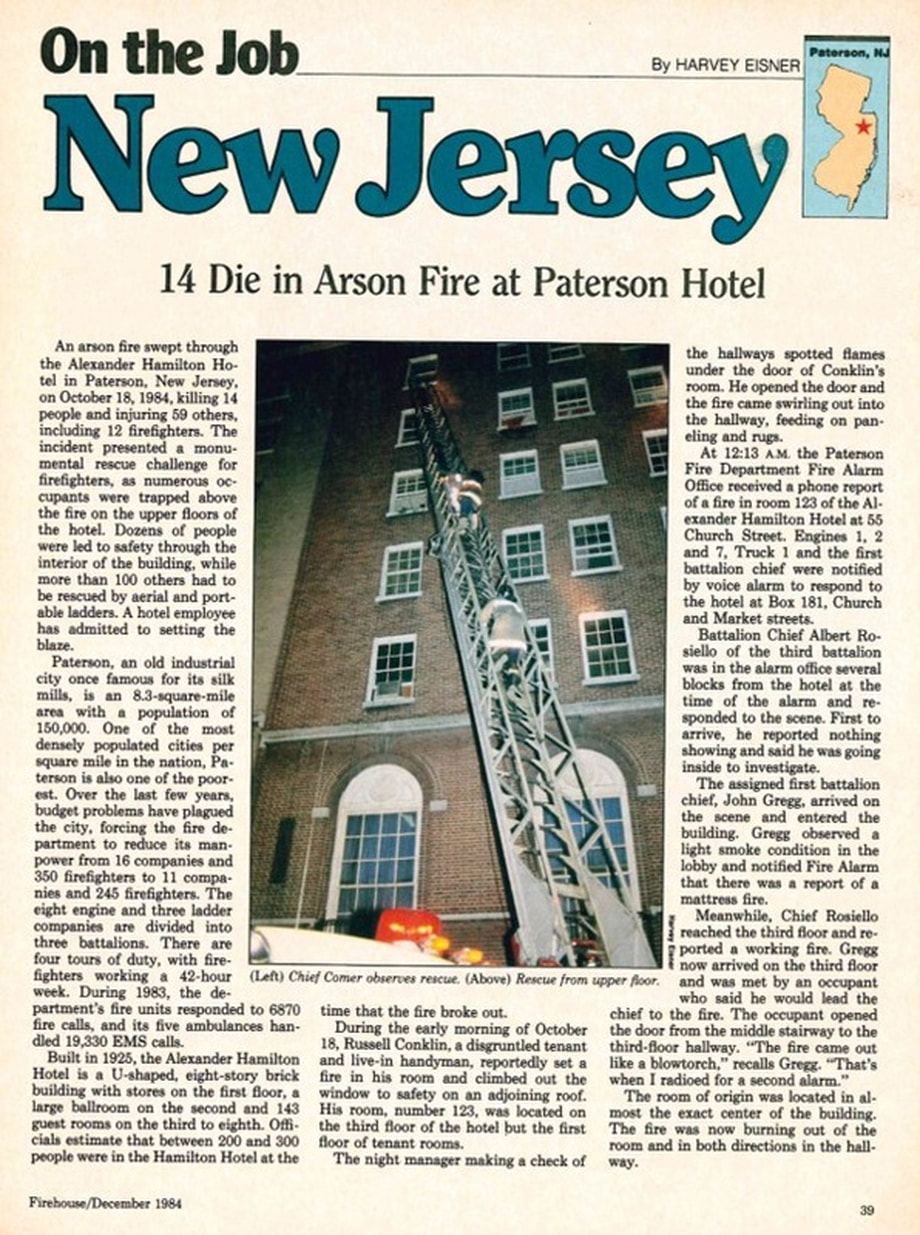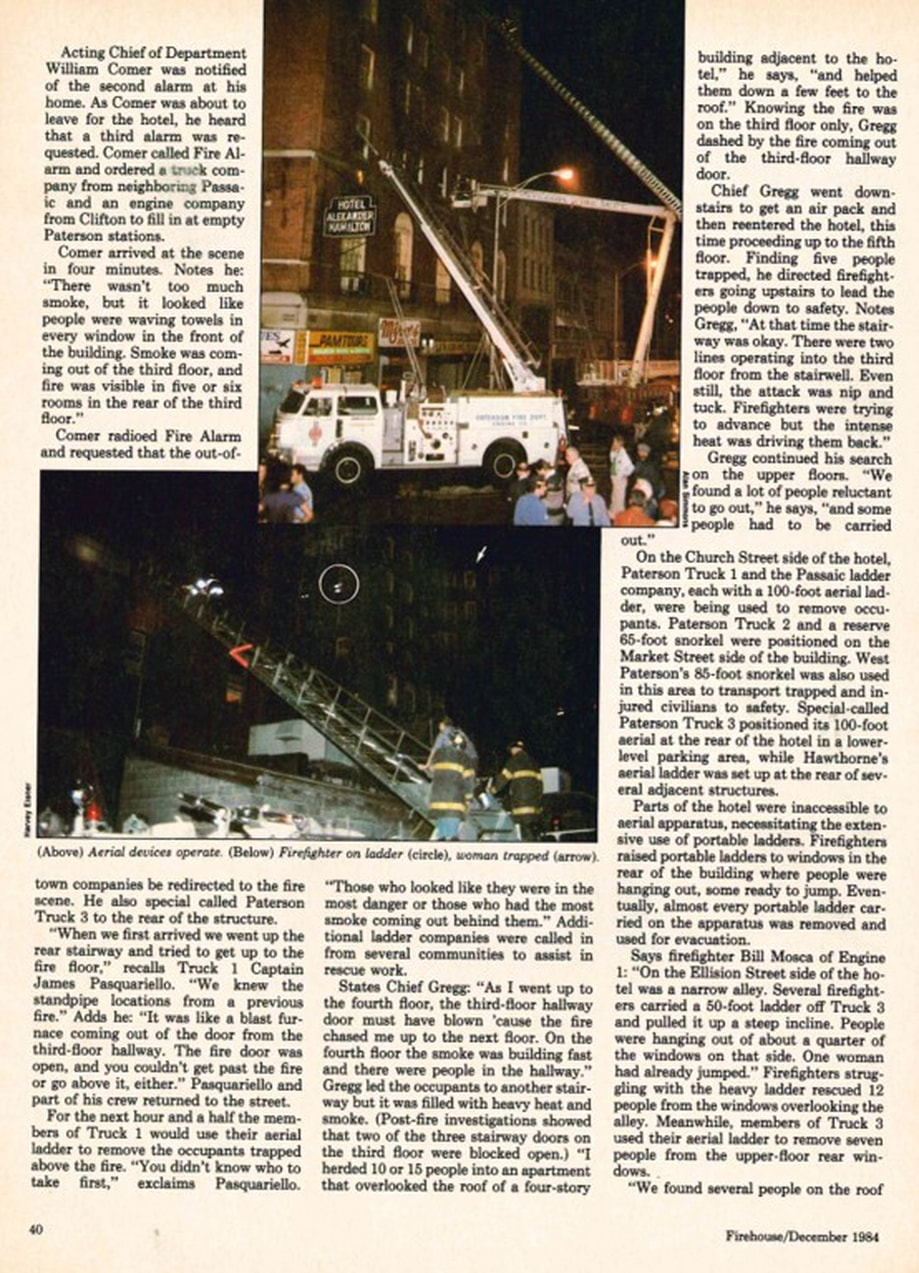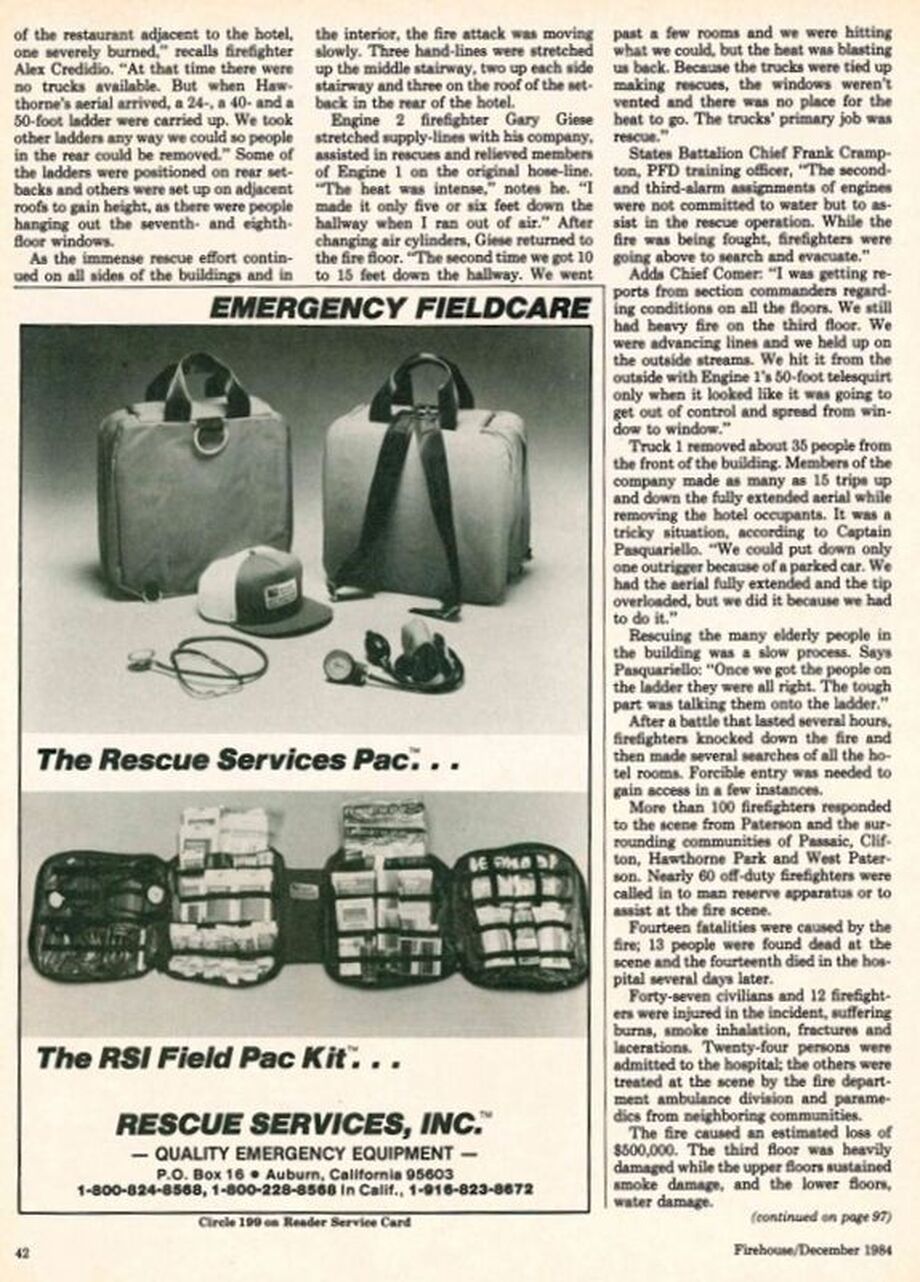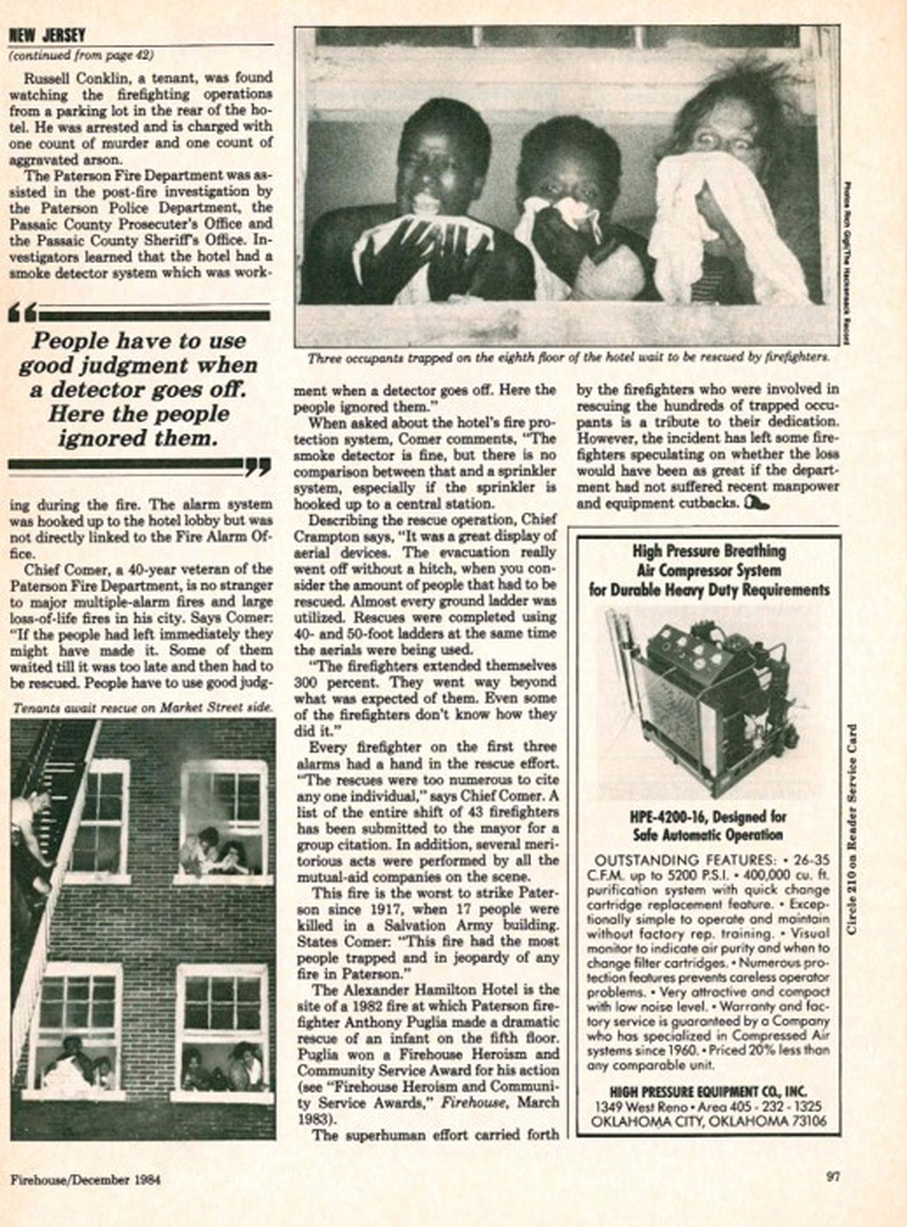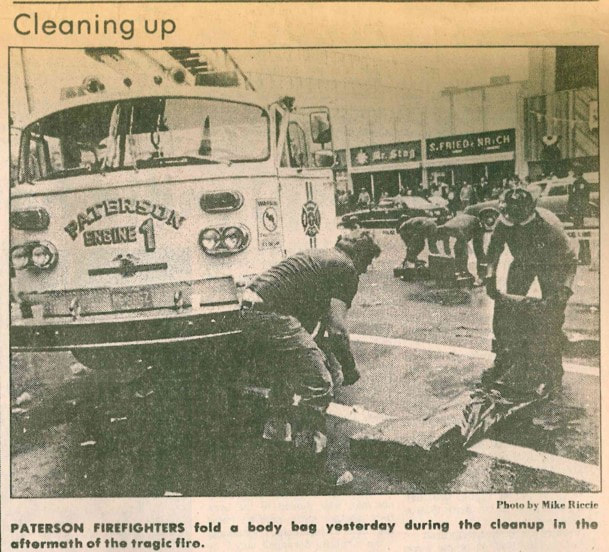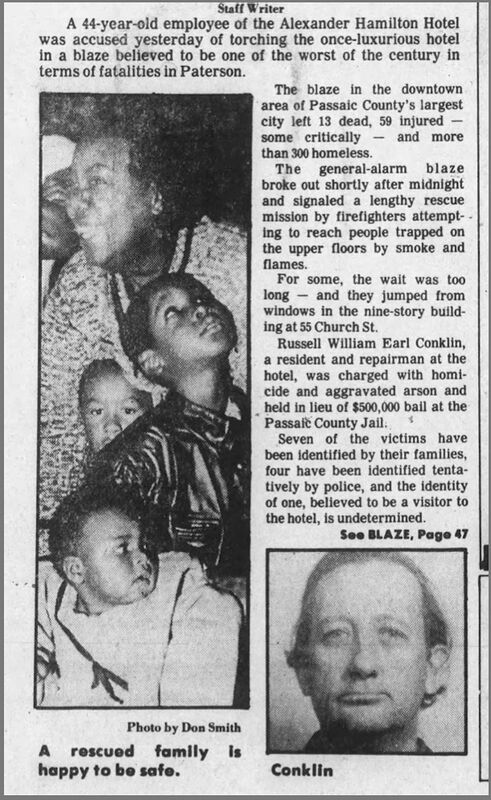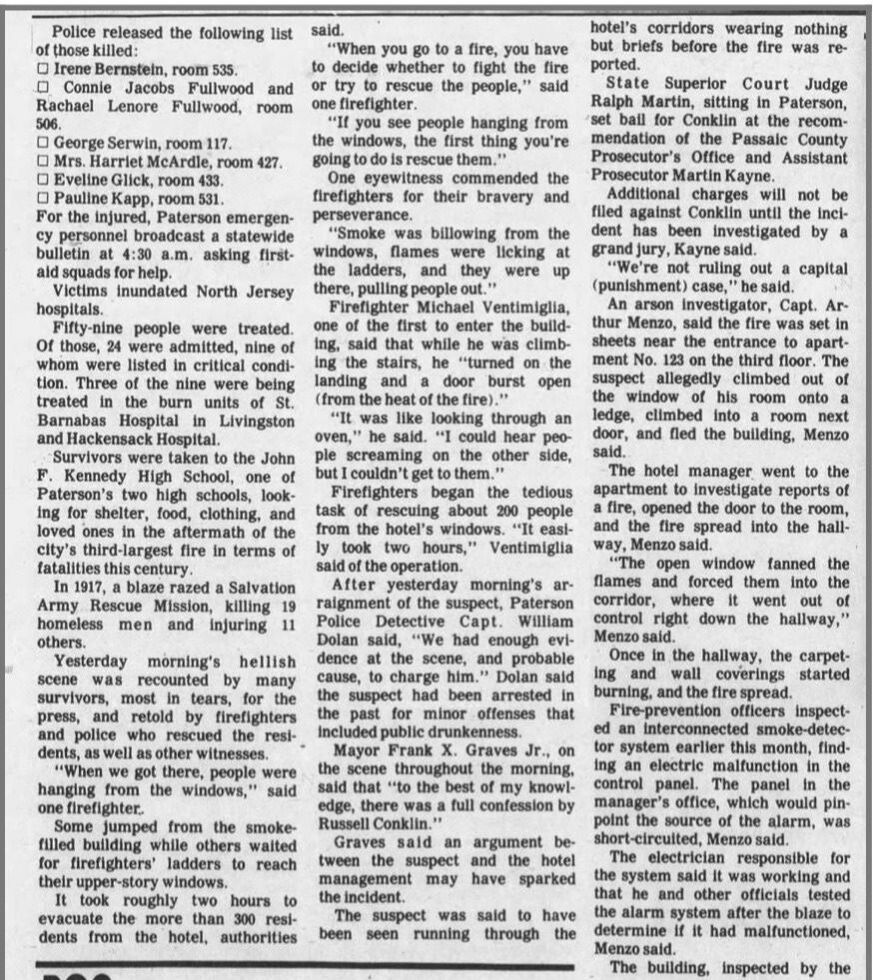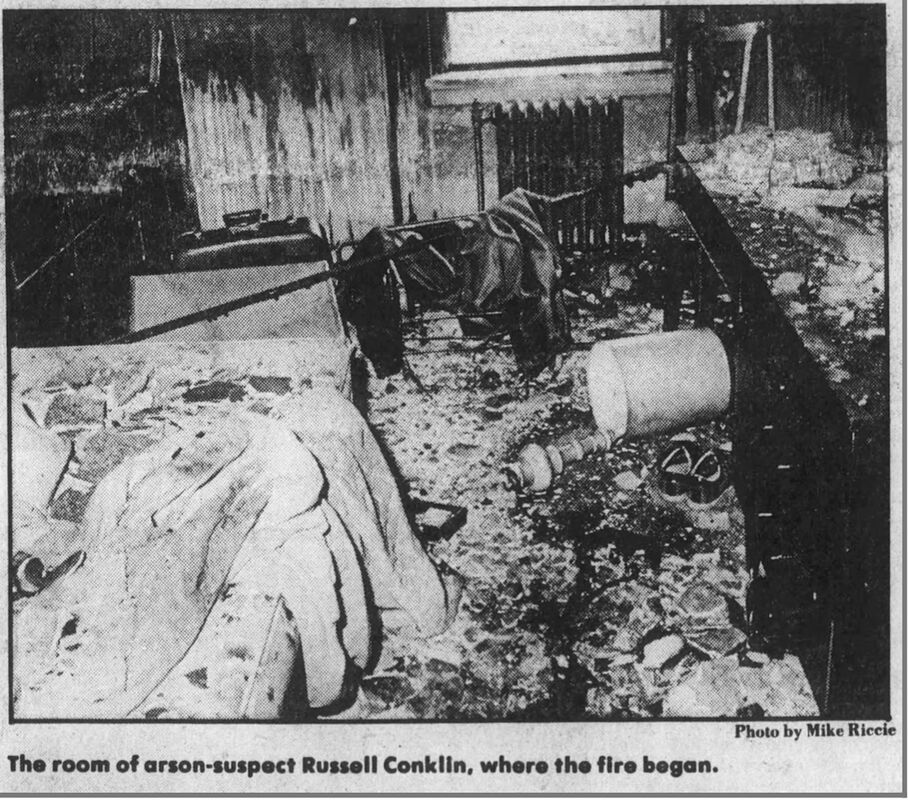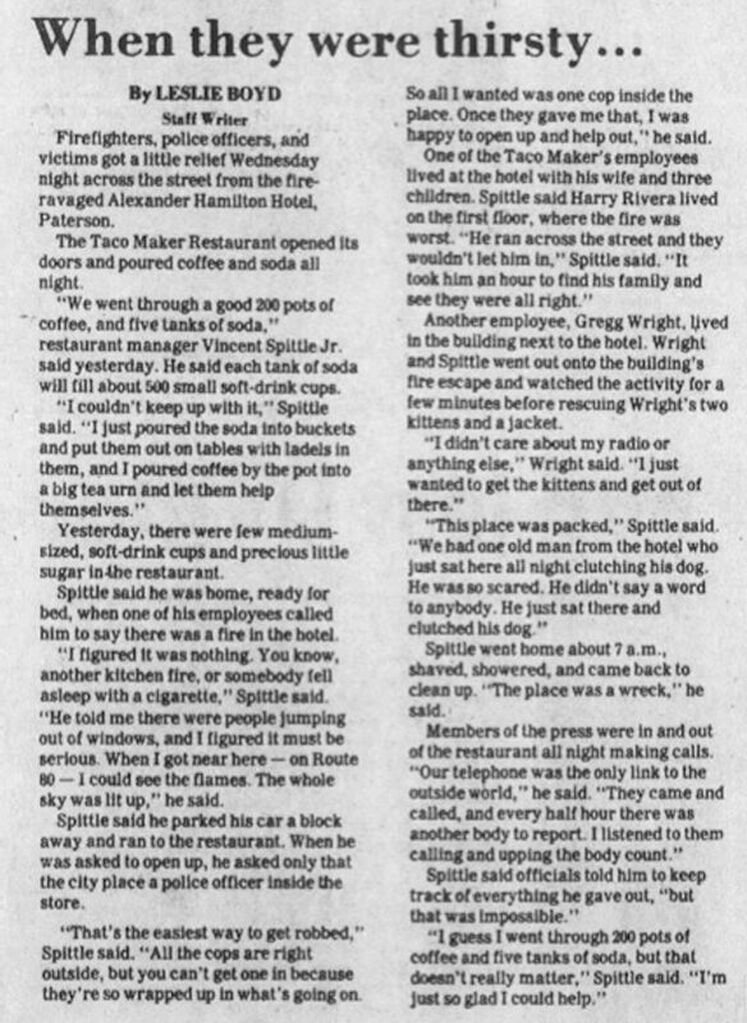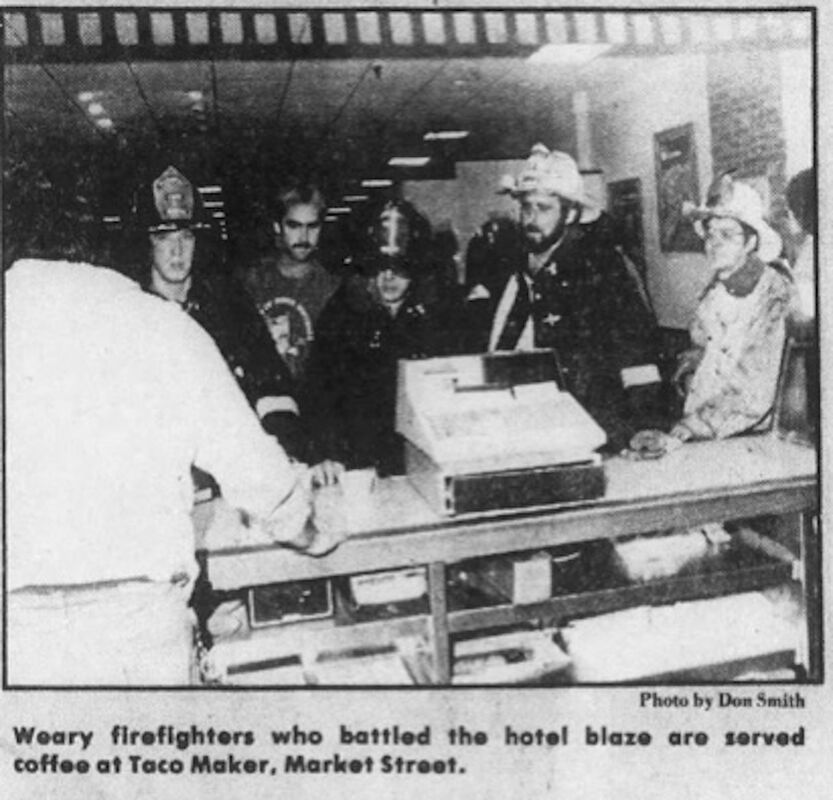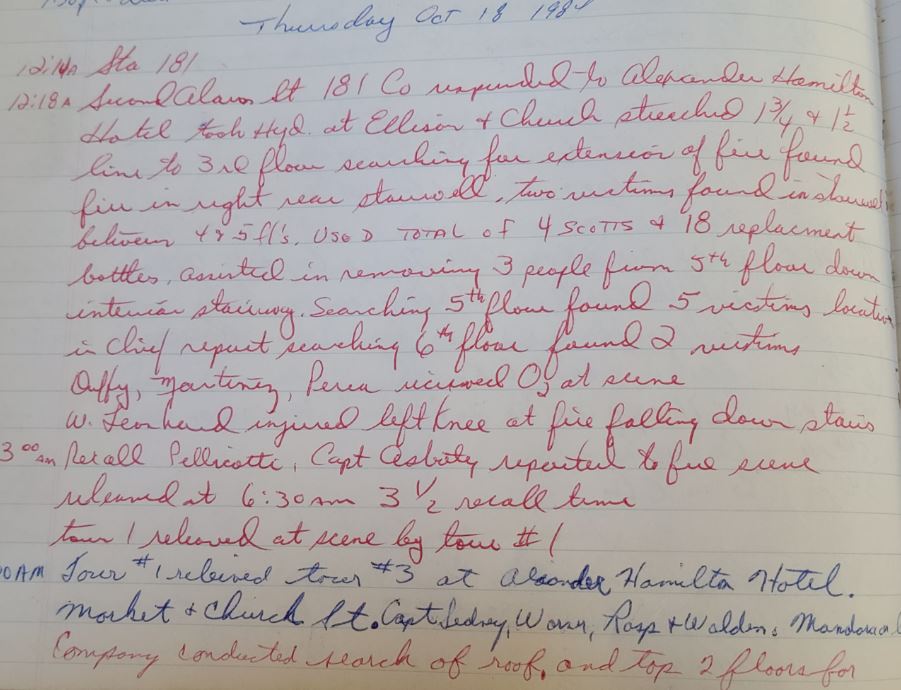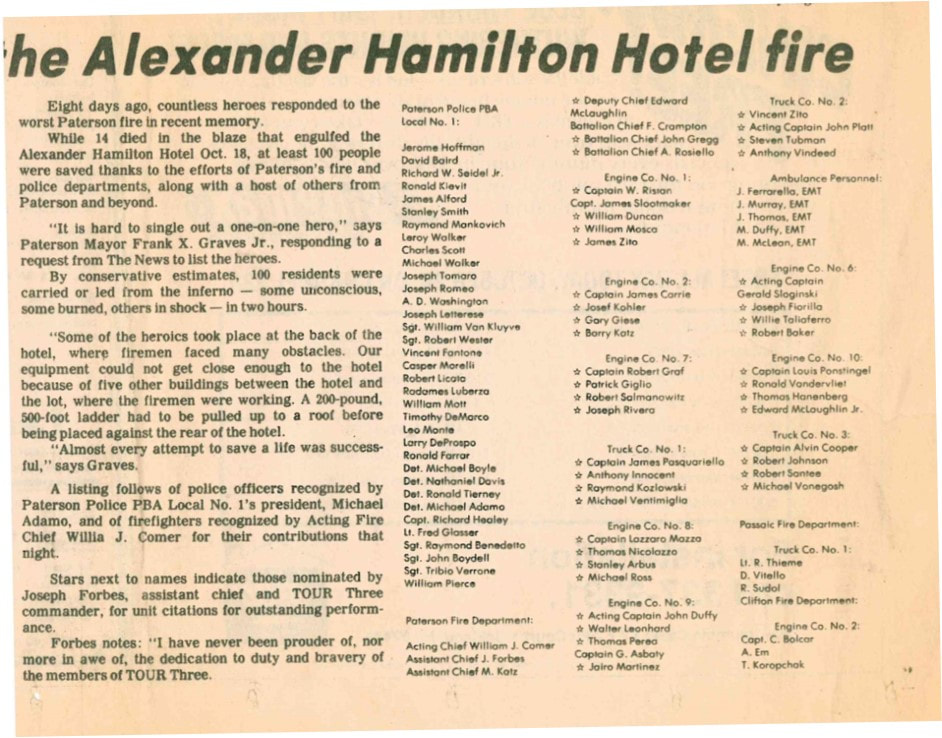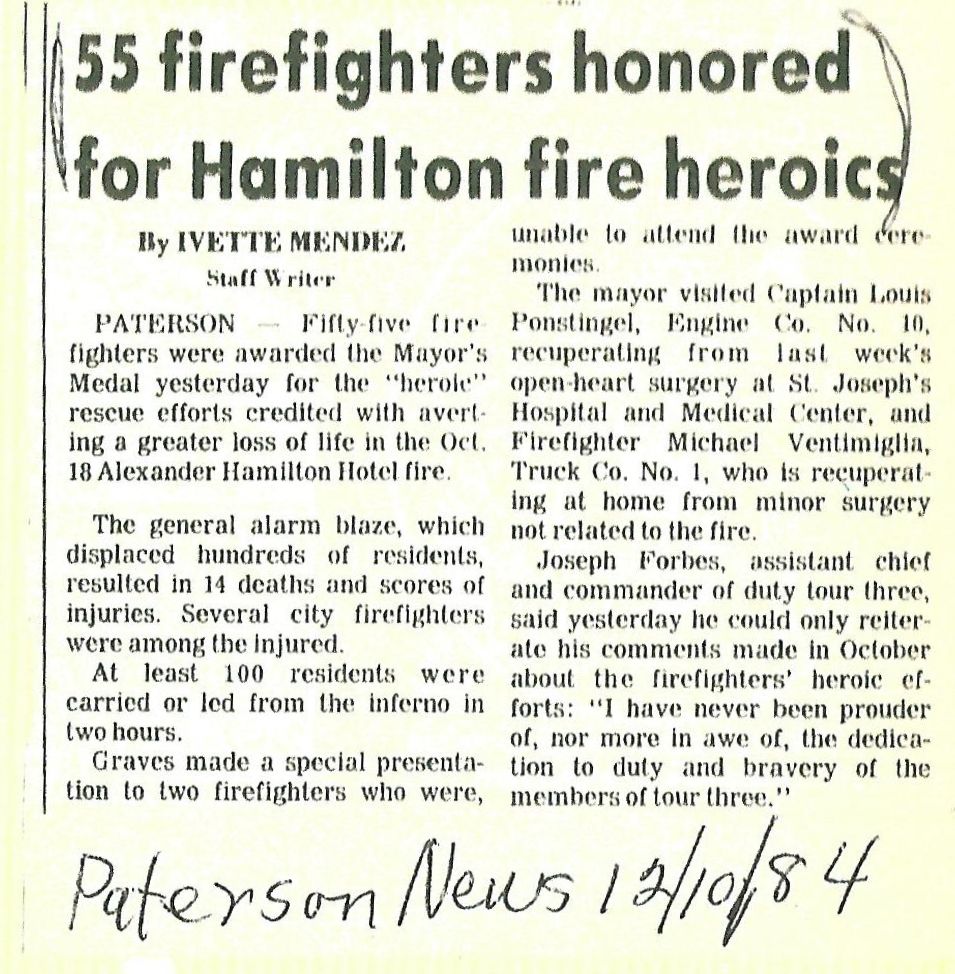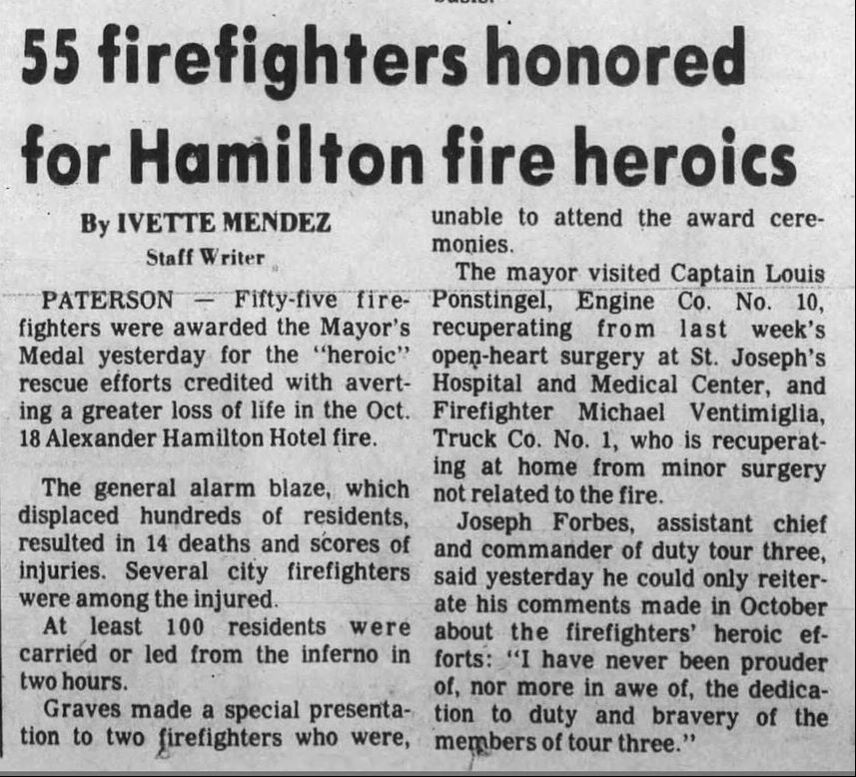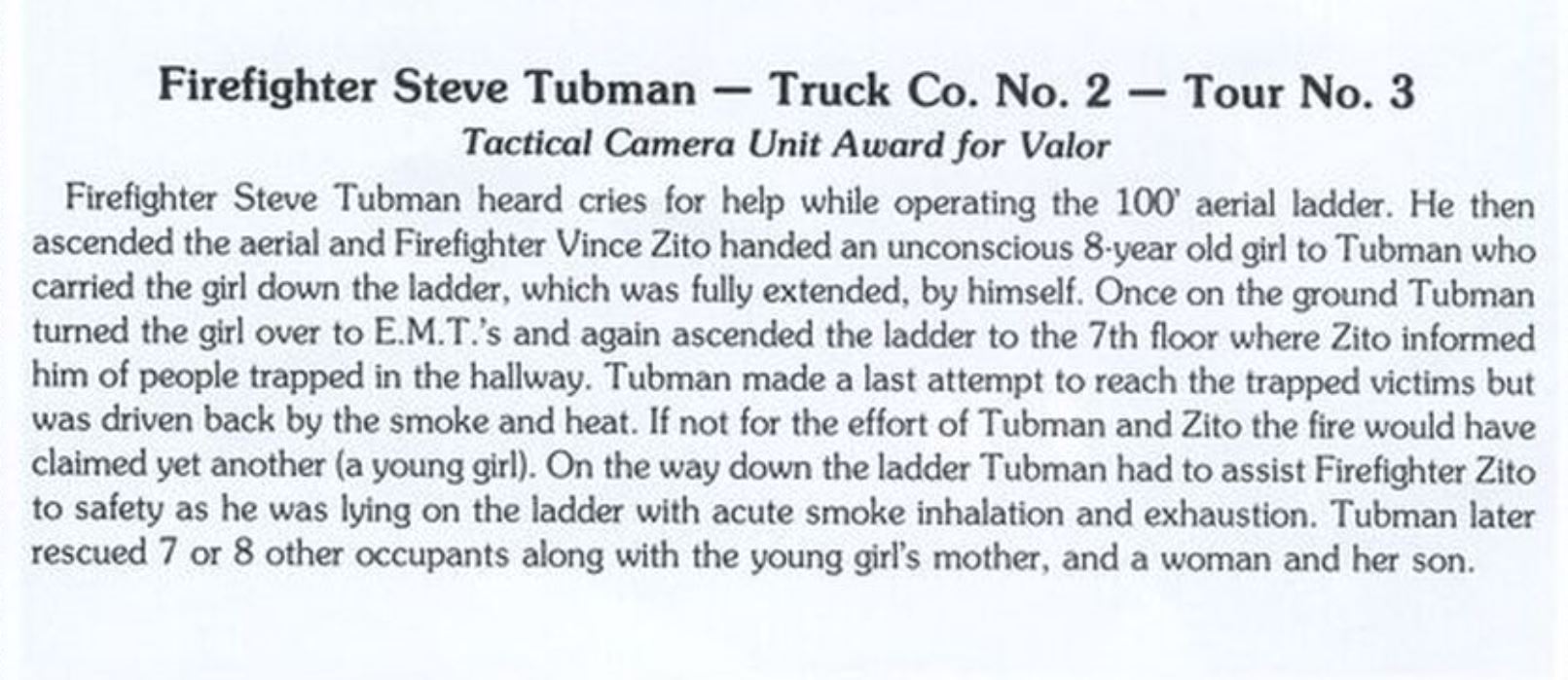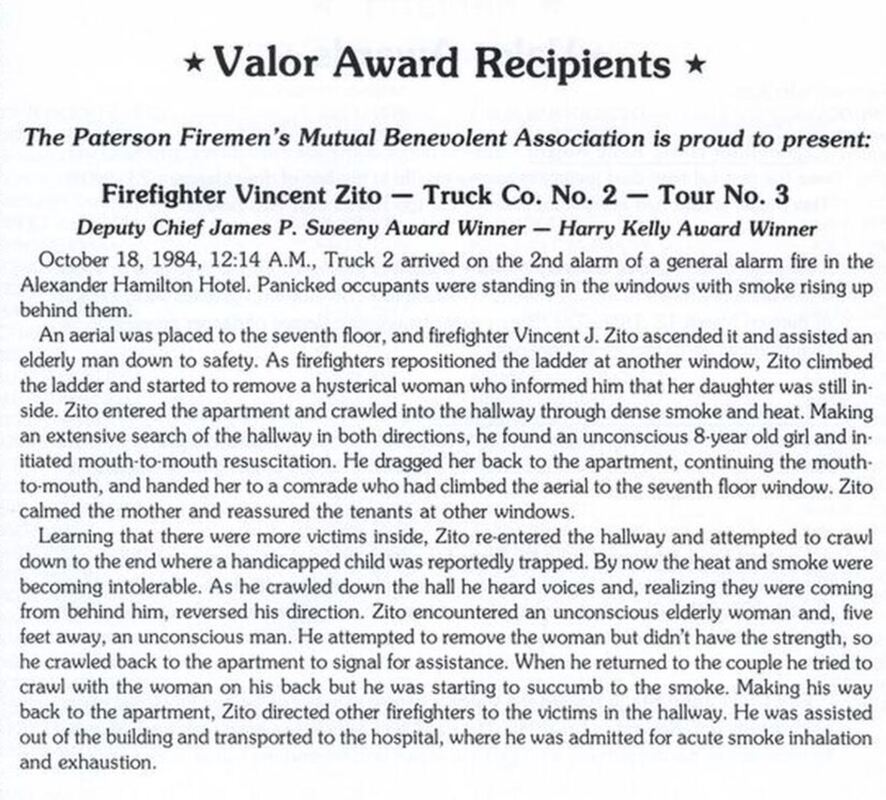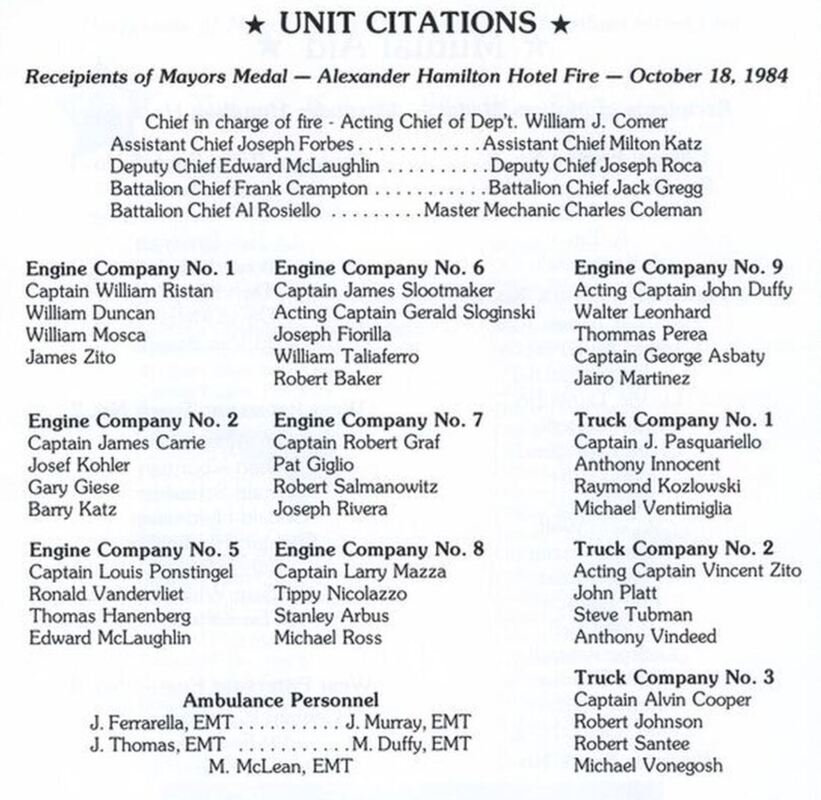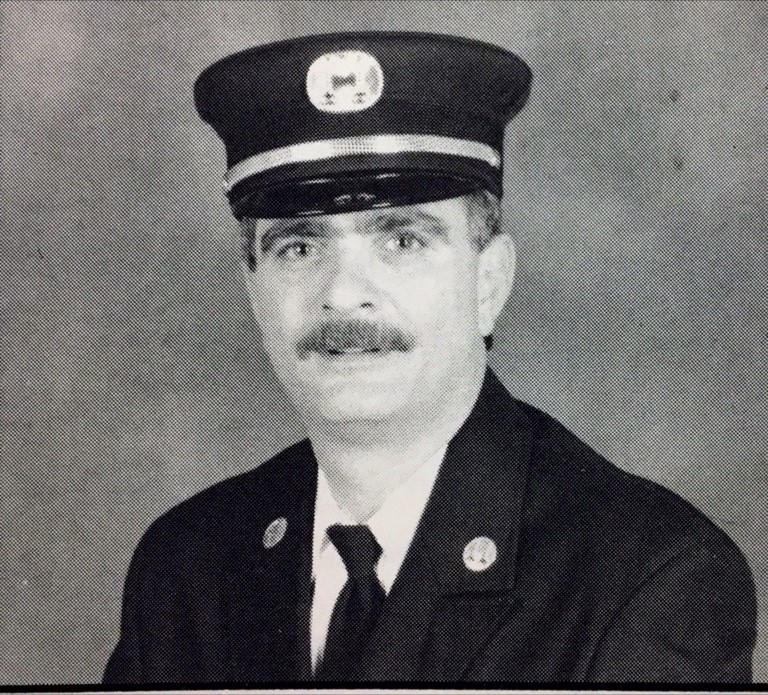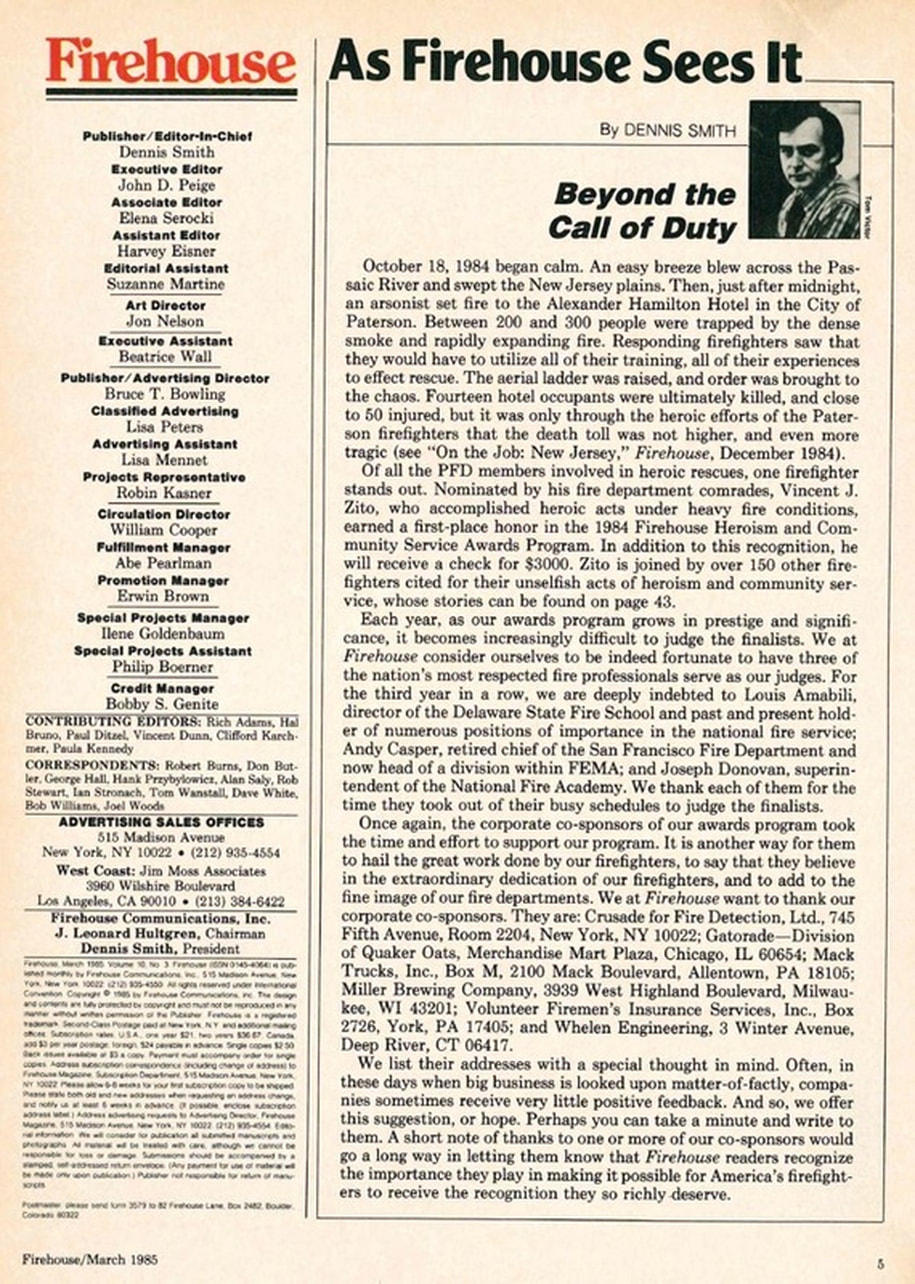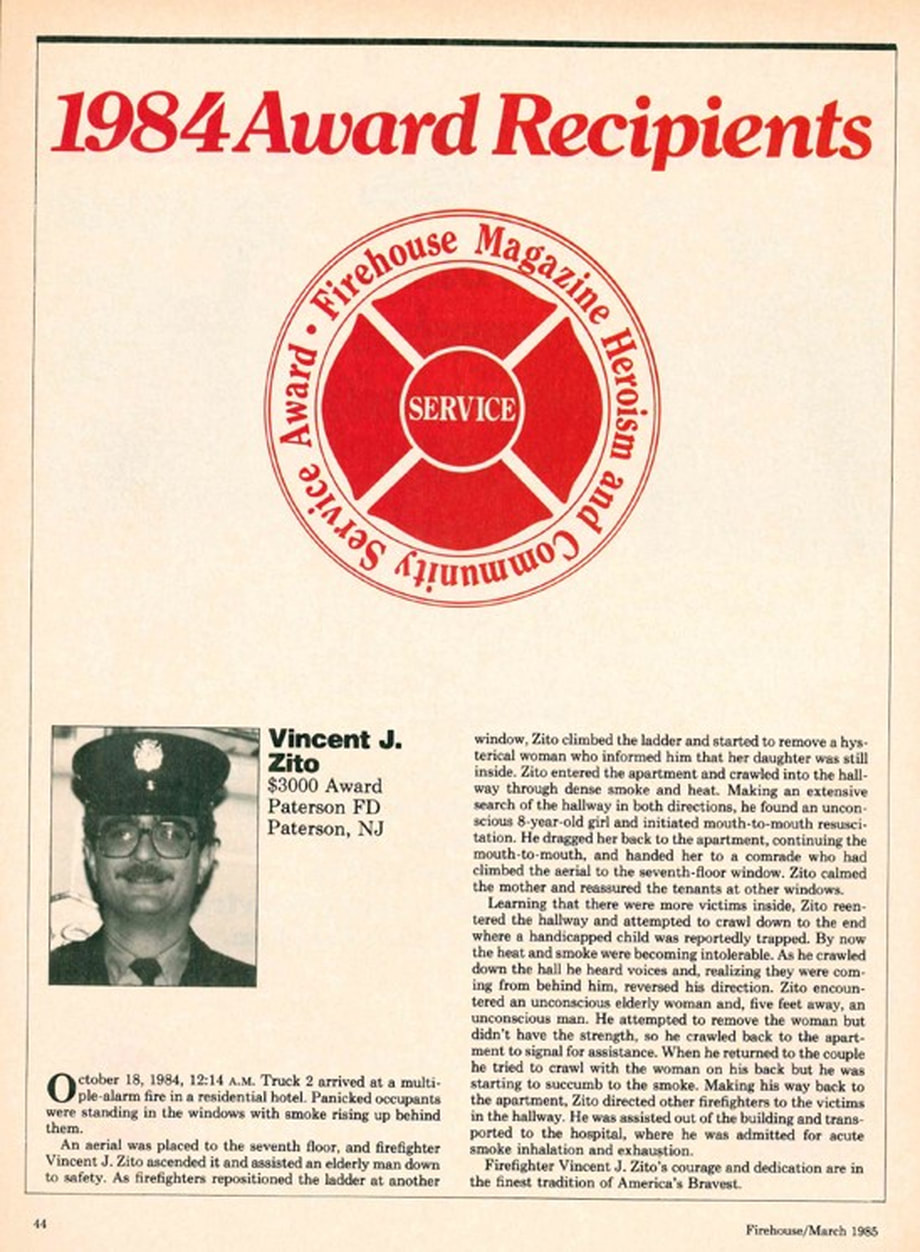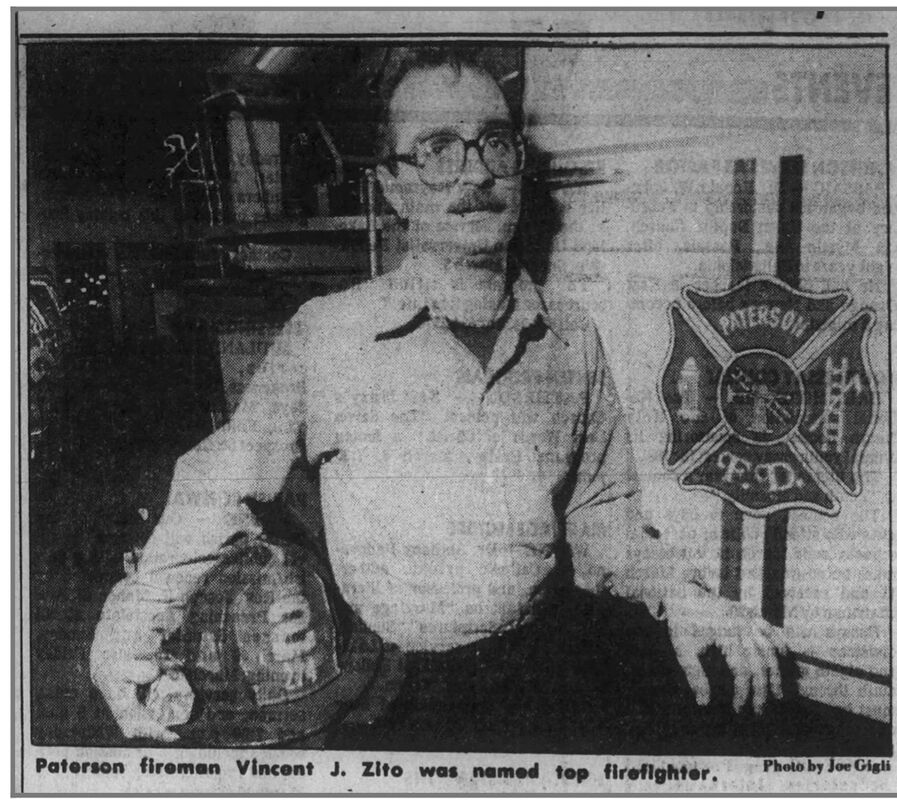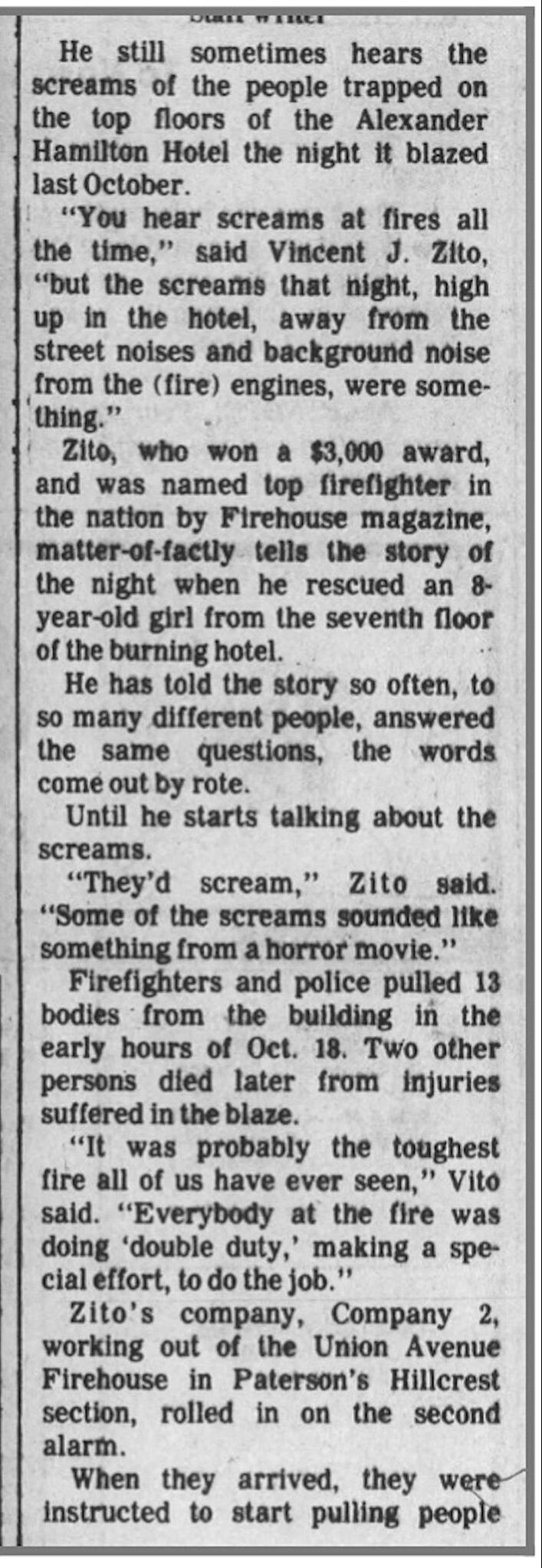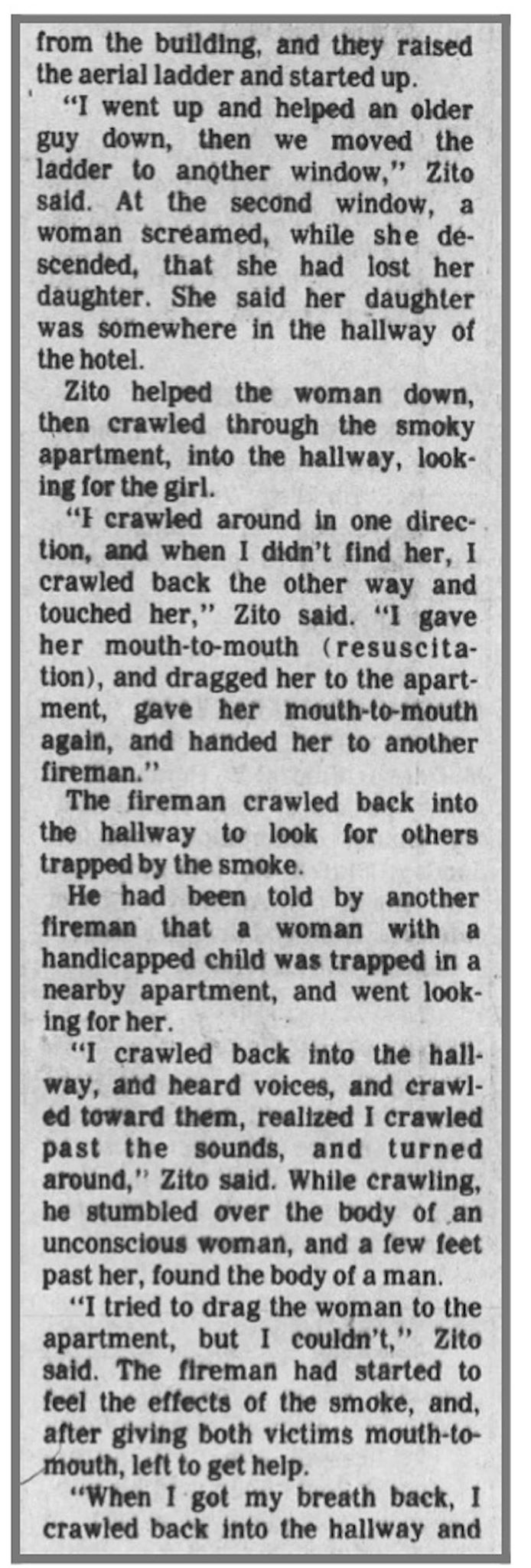- HOME
- OVERVIEW
- FIREFIGHTERS
- CHIEF ENGINEERS TOTAL
- CHIEF ENGINEERS PAID
- THE SUPREME SACRIFICE
- OBITUARIES / DEATHS
-
NOTABLE FIREFIGHTERS
- CALAMITA FAMILY
- CAPTAIN JOHN WEBER
- CUSACK FAMILY
- FLEMING FAMILY
- GERARD DUGAN
- HANCOCK FAMILY
- HENDERSON FAMILY
- HENRY OTIS HARRIS
- ISAAC FELICIANO
- JOHN GILMORE
- JOSEPH DAYSPRING
- JOSEPH FORBES
- KEARNEY-FAMILY
- MARIANI FAMILY
- McLAUGHLIN FAMILY
- MURRAY FAMILY
- PARKIN FAMILY
- SALMANOWITZ BROTHERS
- THE SIMONTONS
- THE SWEENEYS
- TICE FAMILY
- NOTABLE FIRES/INCIDENTS
- SPECIAL OP EVENTS
- TAKING THE HEAT BOOK
- HISTORICAL REVIEWS
- 1907 GUARDIAN
- 1936 HEARD & SEEN COLUMN
- FIREHOUSE PHOTOS / FACTS
- COMPANY & FH HISTORY
- SPECIAL OPERATIONS
- EMS
- COMMUNICATIONS / FA
- FIRE VIDEOS 1991-2011
- FIRE VIDEOS 2014-2022
- DOCUDRAMAS
- APPARATUS
- APPARATUS VIDEOS
- NOTABLE EVENTS INDEX
- MEMORABILIA
- PATCHES DECALS LOGOS SHIRTS
- WALLPAPER
- DEPARTMENT PETS
- TRAINING
-
VOLUNTEER DEPARTMENT
- AUXILIARY FIRE DEPARTMENT
- EXEMPT ASSOCIATION
- EXEMPT HOME & RELICS
- FMBA / PFA
-
BALLBOOKS
- 1909 BALL BOOK
- 1916 BALL BOOK
- 1918 BALL BOOK
- 1921 ANNUAL BALL
- 1923 ANNUAL BALL
- 1928 ANNUAL BALL
- 1935 PFD BOOSTER
- 1936 JANUARY PICTORIAL
- 1936 DECEMBER PICTORIAL
- 1937 ANNUAL BALL
- 1938 ANNUAL BALL
- 1939 ANNUAL BALL
- 1941 ANNUAL BALL
- 1942 ANNUAL BALL
- 1943 ANNUAL BALL
- 1944 ANNUAL BALL
- 1945 ANNUAL BALL
- 1946 ANNUAL BALL
- 1947 ANNUAL BALL
- 1948 ANNUAL BALL
- 1949 ANNUAL BALL
- 1950 ANNUAL BALL
- 1951 ANNUAL BALL
- 1952 ANNUAL BALL
- 1953 ANNUAL BALL
- 1954 ANNUAL BALL
- 1955 ANNUAL BALL
- 1956 ANNUAL BALL
- 1957 ANNUAL BALL
- 1958 ANNUAL BALL
- 1959 ANNUAL BALL
- 1960 ANNUAL BALL
- 1961 ANNUAL BALL
- 1962 ANNUAL BALL
- 1963 ANNUAL BALL
- 1964 ANNUAL BALL
- 1965 ANNUAL BALL
- 1966 ANNUAL BALL
- 1967 ANNUAL BALL
- 1968 ANNUAL BALL
- 1969 ANNUAL BALL
- 1970 ANNUAL BALL
- 1971 ANNUAL BALL
- 1972 ANNUAL BALL
- 1973 ANNUAL BALL
- 1975 ANNUAL BALL
- 1976 ANNUAL BALL
- 1977 ANNUAL BALL
- 1979 ANNUAL BALL
- 1980 ANNUAL BALL
- 1981 ANNUAL BALL
- 1982 ANNUAL BALL
- 1983 ANNUAL BALL
- 1984 ANNUAL BALL
- 1985 ANNUAL BALL
- 1986 ANNUAL BALL
- 1987 ANNUAL BALL
- 1988 ANNUAL BALL
- 1989 ANNUAL BALL
- 1990 ANNUAL BALL
- 1991 ANNUAL BALL
- 1992 ANNUAL BALL
- 1993 ANNUAL BALL
- 1994 ANNUAL BALL
- 1995 ANNUAL BALL
- 1996 ANNUAL BALL
- 1997 ANNUAL BALL
- 1998 ANNUAL BALL
- 1999 ANNUAL BALL
- 2000 ANNUAL BALL
- 2001 ANNUAL BALL
- 2002 ANNUAL BALL
- 2003 ANNUAL BALL
- 2004 ANNUAL BALL
- 2005 ANNUAL BALL
- 2010 ANNUAL BALL
- 2011 ANNUAL BALL
- 2014 ANNUAL BALL
- 2016 ANNUAL BALL
- ANNUAL REPORTS
- PFH CONTRIBUTORS
- ORAL HISTORY
- STATISTICS
- CONTACT
- CITY OF PATERSON
ALEXANDER HAMILTON HOTEL October 18 1984
|
On Oct. 18, 1984, an arson fire swept the shabby Alexander Hamilton Hotel in downtown Paterson - a once elegant building that fell into disrepair - killing 15 people and injuring about 60 others. "People were screaming, trying to tie sheets and blankets together to get out the windows," said hotel resident Lusylvia Rivera, 33, quoted by the Associated Press. She fled with her three children from a room on the first floor of the residential hotel. "The ones who were more scared just went ahead and jumped," Rivera said.
|
Tour 3 on duty: Box 181 - Market and Church streets - was transmitted at 12:14 a.m. and the incident ``quickly escalated to three alarms and all of the city's fire units responded, as did firefighters from five nearby towns,'' The New York Times said. ''We have people trapped, we have people jumping,'' Paterson Fire Capt. Domenick Cotroneo told The Times. Fire Chief William Comer, quoted by the AP, said "the fire spread so fast and the flames were so intense" that the blaze jumped from the third floor through air ducts and engulfed four or five floors of the eight-story hotel.
|
Battalion Chief Frank Crampton said Paterson firefighters encountered "very poor visibility, panicky people, unconscious people lying on floors," according to the AP.
Harry Moore, who escaped from the second floor with his wife and two babies, said "It happened all of the sudden," according to the AP. "A girl knocked on the door and screamed, 'Get out of the place,'" Moore said. "When we got out, the place was in flames. We grabbed what we could, the babies first of course." |
|
Investigators determined paint and other materials stored in the hotel fueled the flames. Passaic, Clifton and Hawthorne were among the communities to send mutual aid. Some victims succumbed to their injuries days later, including Christino Ramirez, 53, who died Oct. 24 at Hackensack Medical Center's burn unit. ''When he arrived here he had third-degree burns over 90 percent of his body,'' said Lisa Hoffman, a hospital spokeswoman quoted by United Press International. Russell W. Conklin, 44, a TV repairman and resident of the hotel, was convicted of manslaughter and arson and sentenced to prison on Nov. 6, 1985. The Washington Post described Conklin as "an embittered handyman who may have been drunk." |
Paterson Mayor Frank X. Graves, quoted by the AP, said Conklin "had a fight with the night manager. He's the one that supposedly started the fire. The manager locked the guy in the room. He lit the sheets on fire and climbed out the back window. The suspect is saying this." Conklin served more than a decade behind bars and was released from a state prison on April 23, 1997, according to the web site of the New Jersey Department of Corrections.
Below is an early news clip published before the number of deaths recognized
For a video produced by Louis Ponstingel about the Hotel Tragedy click the button below
October 19, 1984
October 18, 1984 Station 181 - Journal Entry - Engine Company 11 Tour 3 Captain Roger Dumas, Acting Captain John Duffy, F/F J Martinez, W Leonhard
Listing of Firefighters and policemen at the scene. A star next to the name indicates nomination for a citation by Assistant Chief Joseph Forbes
December 9, 1984: Mayor's Medals to 55 firefighters
1985 Ball Book Valor Awards
April 26, 1985 the FMBA presented the Deputy Chief James P Sweeney Award and the Harry Kelly Award to fireman (Acting Captain) Vincent Zito of Truck Company 2, Tour 3. On February 27, 1985 He also received the Firehouse Magazine Heroism and Community Service Awards program of $3,000 which was the top monetary award in the seventh annual program, the largest of its kind in the country. Zito was cited for his bravery in the Oct. 18, 1984, fire at the Alexander Hamilton Hotel, one of the worst blazes in the city's history. Fourteen people were killed and Zito was hospitalized for a week with acute smoke inhalation and exhaustion.
|
An aerial was raised to the seventh floor. Zito ascended and assisted an elderly man down to safety. He reclimbed and started to remove a hysterical woman who informed him her daughter was still inside. He searched the hotel hallways for people stranded in the dense smoke and heat and he found an unconscious 8-year-old girl on the seventh floor, and gave her mouth-to-mouth resuscitation, dragged her back to an apartment and handed her to a comrade (at the 7th floor window) who carried her down an aerial ladder.
|
Zito went back to the smoky hallway and found two more unconscious people. After trying in vain to drag their bodies to safety, the firefighter, who was near collapse from exhaustion and smoke inhalation, directed fellow firefighters to the victims. 'Firefighter Vincent Zito's courage and dedication is in the finest tradition of America's bravest,' the magazine said.
Paterson News Interview
1985 FMBA Valor Awards and Unit Citations (from ball book)
October 18, 1984: Following review story is courtesy of Rich DeGroot
On October 18, 1984, a late-night arson fire swept through a shabby hotel in downtown Paterson, New Jersey killing 15 people and injuring about 60 others. The fire in the eight-story, unsprinklered building was confined to the third floor but heat and smoke travelled to the upper floors via stairwell enclosure doors that had been blocked open and unprotected ventilation shafts. The majority of deaths occurred on the upper floors. The fire went to three alarms and presented a monumental rescue problem for arriving firefighters as numerous occupants were pleading for help and threatening to jump from the upper-floor windows. Many occupants were led to safety through the interior of the building while more than 100 were rescued by aerial and portable ladders. The fire was deliberating set by a disgruntled hotel occupant who was charged and convicted of murder and arson.
Built in 1925, the Alexander Hamilton Hotel was located at the corner of Market and Church Streets in downtown Paterson. A once elegant building, the structure had fallen into disrepair. The hotel was an eight-story Type I Fire-Resistive steel, concrete and brick structure that had become a haven for transients, the elderly, and the poor. The C-shaped building had a first floor that was occupied by retail stores while a large ballroom was on the second floor. 143 guest rooms were located on the third through eighth floors. The building featured two passenger elevators and a main stairwell centrally located in the unenclosed hallway. Two side stairwells were located near the ends of the hallways. The stairwells had enclosure doors however investigator later determined that several doors had been blocked open on the night of the fire. Unprotected air ducts ran from the third floor to the eight floor. The interior corridors were finished in combustible paneling and carpeting. The building was equipped with a fire standpipe system but lacked a fire sprinkler system. The hotel had a smoke detector alarm system, but it was only hooked up to the hotel lobby and not linked to the Fire Alarm office. Investigators later determined that the fire alarm system was working and sounded the night of the fire. The building had a narrow alley in the rear while adjacent buildings were located on the Market Street and Church Street sides. Officials estimated that between 200 to 300 people were in the hotel on the night the fire broke out.
Paterson is an old industrial city located at the Great Falls on the Passaic River in Northern New Jersey. The city is located about 15 miles west of New York City and is the county seat of Passaic County. The 8.3 square mile city once known for its silk mills and factories, had a population of about 140,000 residents at the time of the incident. Recognized as the first planned industrial city in the United States, waterpower from the falls was harnessing for manufacturing use in the city during the Industrial Revolution. One of the most densely populated cities per square mile in the country, Paterson was also one of the poorest. Budget cuts in the 1970s had reduced the fire department from 16 companies with 350 firefighters to 11 companies with 245 firefighters. Eight engine companies and three ladder companies were divided into three battalions. During 1983, the department had responded to 6870 fire calls and its five ambulances handled 19,330 emergency medical calls.
During the early morning hours of October 18, 1984, Russell Conklin, a disgruntled tenant and live-in handyman, reportedly set a fire in his room and climbed out the window to safety on an adjoining roof. His room, number 123, was on the third floor of the hotel but on the first level of tenant rooms, The night manager making a check of the hallways spotted flames under the door and the fire came swirling out into the hallway, feeding on combustible paneling and rugs.
At 12:13 hours, the Paterson Fire Department Fire Alarm Office received a phone report of a fire in Room 123 of the Alexander Hamilton Hotel at 55 Church Street. Engines 1, 2, and 7, Truck 1 and Battalion 1 were notified to respond. Battalion 3 Albert Rosiello was in the alarm office several blocks from the hotel and responded to the scene. First to arrive, he reported nothing showing and said he was going to investigate. Battalion 1 John Gregg arrived on the scene and entered the building. Gregg observed a light smoke condition in the lobby and notified Fire Alarm that there was a report of a mattress fire.
Meanwhile, Battalion 3 reached the third floor and reported a working fire. Battalion 1 now arrived at the third floor and was met by an occupant who said he would lead him to the fire. The occupant opened the door from the middle stairway to the third-floor hallway. “The fire came out like a blowtorch,” recalled Battalion Chief Gregg. “That’s when I radioed for a second alarm.” The room of origin was located in almost the exact center of the building. The fire was now burning out of the room and in both directions in the undivided hallways.
Acting Chief of Department William Comer was notified of the second alarm. As he was about to leave for the hotel, he heard the third alarm transmitted. Comer called Fire Alarm and ordered a truck company from neighboring Passaic and an engine company from Clifton to fill in at empty Paterson stations. Comer arrived at the scene within four minutes and noted “There wasn’t too much smoke, but it looked like people were waving towels in every window in the front of the building. Smoke was coming out of the third floor, and fire was visible in five or six rooms in the rear of the third floor. Comer radioed Fire Alarm and requested that the out-of-town companies be redirected to the fire scene. He also special called Paterson Truck 3 to the rear of the structure.
Chief Comer, quoted by the Associated Press, said "the fire spread so fast, and the flames were so intense" that the blaze jumped from the third floor through air ducts and engulfed four or five floors of the eight-story hotel. Battalion Chief Frank Crampton said Paterson firefighters encountered "very poor visibility, panicky people, unconscious people lying on floors.”
“When we first arrived, we went up the rear stairway and tried to get up to the fire floor,” recalled Truck 1 Captain James Pasquariello. “We knew the standpipe locations from a previous fire.” He added, “It was like a blast furnace coming out of the door from the third-floor hallway. The fire door was open, and you couldn’t get past the fire or go above it, either.” Pasquariello and part of his crew returned to the street. For the next hour and a half, the members of Truck 1 used their aerial ladder to remove occupants trapped above the fire. “You didn’t know who to take first,” exclaimed Pasquariello. “Those who looked like they were in the most danger or those who had the most smoke coming out behind them.” Additional ladder companies were called in from several communities to assist in the rescue work.
Battalion Chief Gregg stated, “As I went up to the fourth floor, the third-floor hallway door must have blown because the fire chased me up to the next floor. On the fourth floor the smoke was building fast and there were people in the hallway.” Gregg led the occupants to another stairway, but it was filled with heavy heat and smoke. Note: Fire investigators later determined that two of the three stairway doors on the third floor were blocked open on the night of the fire. “I herded 10 or 15 people into an apartment that overlooked the roof of a four-story building adjacent to the hotel,” he said, “and helped them down a few feet to the roof.” Knowing the fire was on the third floor only, Gregg dashed by the fire coming out of the third-floor hallway door.
Chief Gregg went downstairs to get a SCBA and then reentered the hotel, this time proceeding up to the fifth floor. Finding five people trapped, he directed firefighters going upstairs to lead the people down to safety. Gregg said, “At this time the stairway was okay. There were two hose lines operating into the third floor from the stairwell. Even still, the attack was nip and tuck. Firefighters were trying to advance but the intense heat was driving them back.” Gregg continued his search on the upper floors. “We found a lot of people reluctant to go out and some people had to be carried out.”
On the Church Street side of the hotel, Paterson Truck 1 and the Passaic ladder company, each with a 100-foot aerial ladder, were being used to remove occupants. Paterson Truck 2 and a reserve 65-foot snorkel were positioned on the Market Street side of the building. West Paterson’s 85-foot snorkel was also used in this area to transport trapped and injured civilians to safety. Special-called Paterson Truck 3 positioned its 100-foot aerial ladder at the rear of the hotel in a lower-level parking area, while Hawthorne’s aerial ladder was set up at the rear of several adjacent structures.
Parts of the hotel were inaccessible to aerial apparatus, necessitating the extensive use of portable ladders. Firefighters raised portable ladders to windows in the rear of the building where people were hanging out windows, some ready to jump. Eventually, almost every portable ladder carried on the apparatus was removed and used for evacuation. Said Paterson Firefighter Bill Mosca of Engine 1, “On the Ellison Street side of the hotel was a narrow alley. Several firefighters carried a 50-foot ladder off Truck 3 and pulled it up a steep incline. People were hanging out of about a quarter of the windows on that side. One woman had already jumped.” Firefighters struggled with the heavy ladder to rescue 12 people from the windows overlooking the alley. Meanwhile, members of Truck 3 used their aerial ladder to remove seven people from the upper-floor rear windows.
“We found several people on the roof of the restaurant adjacent to the hotel, one severely burned,” recalled Firefighter Alex Credidio. “At that time there were no trucks available. But when Hawthorne’s aerial ladder arrived, a 24-, a 40-, and a 50-foot ladder were carried up. We took other ladders anyway we could so people in the rear could be removed.” Some of the ladders were positioned on rear setbacks and others were set up on adjacent roofs to gain height, as there were people hanging out the seventh- and eighth-floor windows.
"People were screaming, trying to tie sheets and blankets together to get out the windows," said hotel resident Lusylvia Rivera, age 33, quoted by the Associated Press. She fled with her three children from a room on the first floor of the residential hotel. "The ones who were more scared just went ahead and jumped," Rivera said.
As the intense rescue effort continued on all sides of the building and in the interior, the fire attack was moving slowly. Three hose lines were stretched up the middle stairway, two up each side stairway and three on the roof of the setback in the rear of the hotel. Engine 2 Firefighter Gary Giese stretched supply lines with his company, assisted in rescues, and relieved members of Engine 1 on the original hose line. “The heat was intense,” he noted, “I made it only five or six feet down the hallway when I ran out of air.” After changing his air cylinder, Giese returned to the fire floor. “The second time we got 10 to 15 feet down the hallway. We went past a few rooms and hit what we could, but the heat was blasting us back. Because the trucks were tied up making rescues, the windows weren’t vented and there was no place for the heat to go.”
Paterson Battalion Chief Frank Crampton, the department training officer said, “The second- and third-alarm assignments of engines were not committed to water but to assist with the rescue operation. While the fire was being fought, firefighters were going above to search and evacuate.” Added Chief Comer, “I was getting reports from section commanders regarding conditions on all the floors. We still had heavy fire on the third floor. We were advancing hose lines and we held up on the outside streams. We hit it from the outside with Engine 1’s 50-foot telesquirt only when it looked like it was going to get out of control and spread from window to window.”
Truck 1 removed about 35 people from the front of the building. Members of the company made as many as 15 trips up and down their fully extended aerial while removing numerous hotel occupants, It was a tricky situation, according to Captain Pasquariello. “We could only put down one outrigger because of a parked car. We had the aerial fully extended and the tip overloaded, but we did it because we had to do it.” Rescuing the many elderly people in the building was a slow process. Said Pasquariello, “Once we got people on the ladder, they were all right. The tough part was talking them onto the ladder.”
After a battle that lasted several hours, firefighters knocked down the fire and then made several searches of all the hotel rooms. Forcible entry was needed to gain access in a few instances. More than 100 firefighters responded to the scene from Paterson and the surrounding communities of Passaic, Clifton, Hawthorne, and West Paterson. Nearly 60 off-duty Paterson firefighters were called in to man reserve apparatus or to assist at the fire scene. Fifteen fatalities were caused by the fire: 13 people were found dead at the scene and two others died later in hospitals. Forty-seven civilians and 12 firefighters were injured during the incident, suffering burns, smoke inhalation, fractures, and lacerations. Twenty-four persons were admitted to the hospital; others were treated at the scene by the fire department ambulance division and by paramedics from neighboring communities.
The fire caused an estimated loss of $5,000,000. The third floor was heavily damaged by fire while the upper floors sustained smoke damage, and the lower floors had water damage. Investigators determined that paint and other materials stored in the hotel helped fuel the flames.
Russell W. Conklin, age 44, a television repairman and resident of the hotel, was found to be watching the firefighting operations from a parking lot in the rear of the hotel. He was charged and convicted of manslaughter and arson and sentenced to prison on November 6, 1985. The Washington Post described Conklin as "an embittered handyman who may have been drunk." Paterson Mayor Frank X. Graves, quoted by the Associated Press, said Conklin "had a fight with the night manager. He's the one that supposedly started the fire. The manager locked the guy in the room. He lit the sheets on fire and climbed out the back window. The suspect is saying this." Conklin served more than a decade behind bars and was released from a state prison on April 23, 1997, according to the web site of the New Jersey Department of Corrections. Conklin remained released on parole until his death in 2006 at age 63.
Chief Comer, a 40-year veteran of the Paterson Fire Department, was no stranger to major multiple-alarm fires and large loss-of-life fires in the city. Said Comer, “If people had left immediately, they might have made it. Some of them waited till it was too late and then had to be rescued. People have to use good judgement when a detector goes off. Here the people ignored them.” When asked about the hotel’s fire protection system, Comer commented, “The smoke detector is fine, but there is no comparison between that and a sprinkler system, especially if the sprinkler is hooked up to a central station.”
Regarding the rescue operation, Training Chief Crampton said, “It was a great display of aerial devices. The evacuation really went off without a hitch, when you consider the amount of people that had to be rescued. Almost every ground ladder was utilized. Rescues were completed using 40- and 50-foot ladders at the same time the aerials were being used. The firefighters extended themselves 300 percent. They went way beyond what was expected of them. Even some of the firefighters don’t know how they did it.”
Every firefighter on the first three alarms had a hand in the rescue effort. “The rescues were too numerous to cite any one individual,” said Chief Comer. The entire shift of 43 city firefighters were later recognized for their service with a group citation from the mayor and city council. Paterson Firefighters Steve Tubman and Vincent Zito of Truck Company 2 were awarded valor awards for their brave actions having rescued multiple occupants via aerial ladder from the seventh floor under high heat and dense smoke conditions during the fire.
Following the fire, the Alexander Hamilton Hotel was refurbished and reopened. Some years later the building was renovated and converted into rental apartments now known as the Fabian-Alexandria Apartments. The building also now features a full fire sprinkler system.
On October 18, 1984, a late-night arson fire swept through a shabby hotel in downtown Paterson, New Jersey killing 15 people and injuring about 60 others. The fire in the eight-story, unsprinklered building was confined to the third floor but heat and smoke travelled to the upper floors via stairwell enclosure doors that had been blocked open and unprotected ventilation shafts. The majority of deaths occurred on the upper floors. The fire went to three alarms and presented a monumental rescue problem for arriving firefighters as numerous occupants were pleading for help and threatening to jump from the upper-floor windows. Many occupants were led to safety through the interior of the building while more than 100 were rescued by aerial and portable ladders. The fire was deliberating set by a disgruntled hotel occupant who was charged and convicted of murder and arson.
Built in 1925, the Alexander Hamilton Hotel was located at the corner of Market and Church Streets in downtown Paterson. A once elegant building, the structure had fallen into disrepair. The hotel was an eight-story Type I Fire-Resistive steel, concrete and brick structure that had become a haven for transients, the elderly, and the poor. The C-shaped building had a first floor that was occupied by retail stores while a large ballroom was on the second floor. 143 guest rooms were located on the third through eighth floors. The building featured two passenger elevators and a main stairwell centrally located in the unenclosed hallway. Two side stairwells were located near the ends of the hallways. The stairwells had enclosure doors however investigator later determined that several doors had been blocked open on the night of the fire. Unprotected air ducts ran from the third floor to the eight floor. The interior corridors were finished in combustible paneling and carpeting. The building was equipped with a fire standpipe system but lacked a fire sprinkler system. The hotel had a smoke detector alarm system, but it was only hooked up to the hotel lobby and not linked to the Fire Alarm office. Investigators later determined that the fire alarm system was working and sounded the night of the fire. The building had a narrow alley in the rear while adjacent buildings were located on the Market Street and Church Street sides. Officials estimated that between 200 to 300 people were in the hotel on the night the fire broke out.
Paterson is an old industrial city located at the Great Falls on the Passaic River in Northern New Jersey. The city is located about 15 miles west of New York City and is the county seat of Passaic County. The 8.3 square mile city once known for its silk mills and factories, had a population of about 140,000 residents at the time of the incident. Recognized as the first planned industrial city in the United States, waterpower from the falls was harnessing for manufacturing use in the city during the Industrial Revolution. One of the most densely populated cities per square mile in the country, Paterson was also one of the poorest. Budget cuts in the 1970s had reduced the fire department from 16 companies with 350 firefighters to 11 companies with 245 firefighters. Eight engine companies and three ladder companies were divided into three battalions. During 1983, the department had responded to 6870 fire calls and its five ambulances handled 19,330 emergency medical calls.
During the early morning hours of October 18, 1984, Russell Conklin, a disgruntled tenant and live-in handyman, reportedly set a fire in his room and climbed out the window to safety on an adjoining roof. His room, number 123, was on the third floor of the hotel but on the first level of tenant rooms, The night manager making a check of the hallways spotted flames under the door and the fire came swirling out into the hallway, feeding on combustible paneling and rugs.
At 12:13 hours, the Paterson Fire Department Fire Alarm Office received a phone report of a fire in Room 123 of the Alexander Hamilton Hotel at 55 Church Street. Engines 1, 2, and 7, Truck 1 and Battalion 1 were notified to respond. Battalion 3 Albert Rosiello was in the alarm office several blocks from the hotel and responded to the scene. First to arrive, he reported nothing showing and said he was going to investigate. Battalion 1 John Gregg arrived on the scene and entered the building. Gregg observed a light smoke condition in the lobby and notified Fire Alarm that there was a report of a mattress fire.
Meanwhile, Battalion 3 reached the third floor and reported a working fire. Battalion 1 now arrived at the third floor and was met by an occupant who said he would lead him to the fire. The occupant opened the door from the middle stairway to the third-floor hallway. “The fire came out like a blowtorch,” recalled Battalion Chief Gregg. “That’s when I radioed for a second alarm.” The room of origin was located in almost the exact center of the building. The fire was now burning out of the room and in both directions in the undivided hallways.
Acting Chief of Department William Comer was notified of the second alarm. As he was about to leave for the hotel, he heard the third alarm transmitted. Comer called Fire Alarm and ordered a truck company from neighboring Passaic and an engine company from Clifton to fill in at empty Paterson stations. Comer arrived at the scene within four minutes and noted “There wasn’t too much smoke, but it looked like people were waving towels in every window in the front of the building. Smoke was coming out of the third floor, and fire was visible in five or six rooms in the rear of the third floor. Comer radioed Fire Alarm and requested that the out-of-town companies be redirected to the fire scene. He also special called Paterson Truck 3 to the rear of the structure.
Chief Comer, quoted by the Associated Press, said "the fire spread so fast, and the flames were so intense" that the blaze jumped from the third floor through air ducts and engulfed four or five floors of the eight-story hotel. Battalion Chief Frank Crampton said Paterson firefighters encountered "very poor visibility, panicky people, unconscious people lying on floors.”
“When we first arrived, we went up the rear stairway and tried to get up to the fire floor,” recalled Truck 1 Captain James Pasquariello. “We knew the standpipe locations from a previous fire.” He added, “It was like a blast furnace coming out of the door from the third-floor hallway. The fire door was open, and you couldn’t get past the fire or go above it, either.” Pasquariello and part of his crew returned to the street. For the next hour and a half, the members of Truck 1 used their aerial ladder to remove occupants trapped above the fire. “You didn’t know who to take first,” exclaimed Pasquariello. “Those who looked like they were in the most danger or those who had the most smoke coming out behind them.” Additional ladder companies were called in from several communities to assist in the rescue work.
Battalion Chief Gregg stated, “As I went up to the fourth floor, the third-floor hallway door must have blown because the fire chased me up to the next floor. On the fourth floor the smoke was building fast and there were people in the hallway.” Gregg led the occupants to another stairway, but it was filled with heavy heat and smoke. Note: Fire investigators later determined that two of the three stairway doors on the third floor were blocked open on the night of the fire. “I herded 10 or 15 people into an apartment that overlooked the roof of a four-story building adjacent to the hotel,” he said, “and helped them down a few feet to the roof.” Knowing the fire was on the third floor only, Gregg dashed by the fire coming out of the third-floor hallway door.
Chief Gregg went downstairs to get a SCBA and then reentered the hotel, this time proceeding up to the fifth floor. Finding five people trapped, he directed firefighters going upstairs to lead the people down to safety. Gregg said, “At this time the stairway was okay. There were two hose lines operating into the third floor from the stairwell. Even still, the attack was nip and tuck. Firefighters were trying to advance but the intense heat was driving them back.” Gregg continued his search on the upper floors. “We found a lot of people reluctant to go out and some people had to be carried out.”
On the Church Street side of the hotel, Paterson Truck 1 and the Passaic ladder company, each with a 100-foot aerial ladder, were being used to remove occupants. Paterson Truck 2 and a reserve 65-foot snorkel were positioned on the Market Street side of the building. West Paterson’s 85-foot snorkel was also used in this area to transport trapped and injured civilians to safety. Special-called Paterson Truck 3 positioned its 100-foot aerial ladder at the rear of the hotel in a lower-level parking area, while Hawthorne’s aerial ladder was set up at the rear of several adjacent structures.
Parts of the hotel were inaccessible to aerial apparatus, necessitating the extensive use of portable ladders. Firefighters raised portable ladders to windows in the rear of the building where people were hanging out windows, some ready to jump. Eventually, almost every portable ladder carried on the apparatus was removed and used for evacuation. Said Paterson Firefighter Bill Mosca of Engine 1, “On the Ellison Street side of the hotel was a narrow alley. Several firefighters carried a 50-foot ladder off Truck 3 and pulled it up a steep incline. People were hanging out of about a quarter of the windows on that side. One woman had already jumped.” Firefighters struggled with the heavy ladder to rescue 12 people from the windows overlooking the alley. Meanwhile, members of Truck 3 used their aerial ladder to remove seven people from the upper-floor rear windows.
“We found several people on the roof of the restaurant adjacent to the hotel, one severely burned,” recalled Firefighter Alex Credidio. “At that time there were no trucks available. But when Hawthorne’s aerial ladder arrived, a 24-, a 40-, and a 50-foot ladder were carried up. We took other ladders anyway we could so people in the rear could be removed.” Some of the ladders were positioned on rear setbacks and others were set up on adjacent roofs to gain height, as there were people hanging out the seventh- and eighth-floor windows.
"People were screaming, trying to tie sheets and blankets together to get out the windows," said hotel resident Lusylvia Rivera, age 33, quoted by the Associated Press. She fled with her three children from a room on the first floor of the residential hotel. "The ones who were more scared just went ahead and jumped," Rivera said.
As the intense rescue effort continued on all sides of the building and in the interior, the fire attack was moving slowly. Three hose lines were stretched up the middle stairway, two up each side stairway and three on the roof of the setback in the rear of the hotel. Engine 2 Firefighter Gary Giese stretched supply lines with his company, assisted in rescues, and relieved members of Engine 1 on the original hose line. “The heat was intense,” he noted, “I made it only five or six feet down the hallway when I ran out of air.” After changing his air cylinder, Giese returned to the fire floor. “The second time we got 10 to 15 feet down the hallway. We went past a few rooms and hit what we could, but the heat was blasting us back. Because the trucks were tied up making rescues, the windows weren’t vented and there was no place for the heat to go.”
Paterson Battalion Chief Frank Crampton, the department training officer said, “The second- and third-alarm assignments of engines were not committed to water but to assist with the rescue operation. While the fire was being fought, firefighters were going above to search and evacuate.” Added Chief Comer, “I was getting reports from section commanders regarding conditions on all the floors. We still had heavy fire on the third floor. We were advancing hose lines and we held up on the outside streams. We hit it from the outside with Engine 1’s 50-foot telesquirt only when it looked like it was going to get out of control and spread from window to window.”
Truck 1 removed about 35 people from the front of the building. Members of the company made as many as 15 trips up and down their fully extended aerial while removing numerous hotel occupants, It was a tricky situation, according to Captain Pasquariello. “We could only put down one outrigger because of a parked car. We had the aerial fully extended and the tip overloaded, but we did it because we had to do it.” Rescuing the many elderly people in the building was a slow process. Said Pasquariello, “Once we got people on the ladder, they were all right. The tough part was talking them onto the ladder.”
After a battle that lasted several hours, firefighters knocked down the fire and then made several searches of all the hotel rooms. Forcible entry was needed to gain access in a few instances. More than 100 firefighters responded to the scene from Paterson and the surrounding communities of Passaic, Clifton, Hawthorne, and West Paterson. Nearly 60 off-duty Paterson firefighters were called in to man reserve apparatus or to assist at the fire scene. Fifteen fatalities were caused by the fire: 13 people were found dead at the scene and two others died later in hospitals. Forty-seven civilians and 12 firefighters were injured during the incident, suffering burns, smoke inhalation, fractures, and lacerations. Twenty-four persons were admitted to the hospital; others were treated at the scene by the fire department ambulance division and by paramedics from neighboring communities.
The fire caused an estimated loss of $5,000,000. The third floor was heavily damaged by fire while the upper floors sustained smoke damage, and the lower floors had water damage. Investigators determined that paint and other materials stored in the hotel helped fuel the flames.
Russell W. Conklin, age 44, a television repairman and resident of the hotel, was found to be watching the firefighting operations from a parking lot in the rear of the hotel. He was charged and convicted of manslaughter and arson and sentenced to prison on November 6, 1985. The Washington Post described Conklin as "an embittered handyman who may have been drunk." Paterson Mayor Frank X. Graves, quoted by the Associated Press, said Conklin "had a fight with the night manager. He's the one that supposedly started the fire. The manager locked the guy in the room. He lit the sheets on fire and climbed out the back window. The suspect is saying this." Conklin served more than a decade behind bars and was released from a state prison on April 23, 1997, according to the web site of the New Jersey Department of Corrections. Conklin remained released on parole until his death in 2006 at age 63.
Chief Comer, a 40-year veteran of the Paterson Fire Department, was no stranger to major multiple-alarm fires and large loss-of-life fires in the city. Said Comer, “If people had left immediately, they might have made it. Some of them waited till it was too late and then had to be rescued. People have to use good judgement when a detector goes off. Here the people ignored them.” When asked about the hotel’s fire protection system, Comer commented, “The smoke detector is fine, but there is no comparison between that and a sprinkler system, especially if the sprinkler is hooked up to a central station.”
Regarding the rescue operation, Training Chief Crampton said, “It was a great display of aerial devices. The evacuation really went off without a hitch, when you consider the amount of people that had to be rescued. Almost every ground ladder was utilized. Rescues were completed using 40- and 50-foot ladders at the same time the aerials were being used. The firefighters extended themselves 300 percent. They went way beyond what was expected of them. Even some of the firefighters don’t know how they did it.”
Every firefighter on the first three alarms had a hand in the rescue effort. “The rescues were too numerous to cite any one individual,” said Chief Comer. The entire shift of 43 city firefighters were later recognized for their service with a group citation from the mayor and city council. Paterson Firefighters Steve Tubman and Vincent Zito of Truck Company 2 were awarded valor awards for their brave actions having rescued multiple occupants via aerial ladder from the seventh floor under high heat and dense smoke conditions during the fire.
Following the fire, the Alexander Hamilton Hotel was refurbished and reopened. Some years later the building was renovated and converted into rental apartments now known as the Fabian-Alexandria Apartments. The building also now features a full fire sprinkler system.
Proudly powered by Weebly
